| Travel Photos Home Page |
Moscow 2017 - Part One - The City
|
||||
|
To return to the Paintings section of this website, please CLICK HERE
|
|||
|
To return to the Eastern Europe 2017 page, please CLICK HERE
|
|||
| There is a lot to see in Moscow, so I am showing it in two parts. This first part will show the City, Red Square and the Kremlin. Part Two will showcase the two famous art museums of Moscow... the Pushkin and the Tretyakov Galleries. | |||
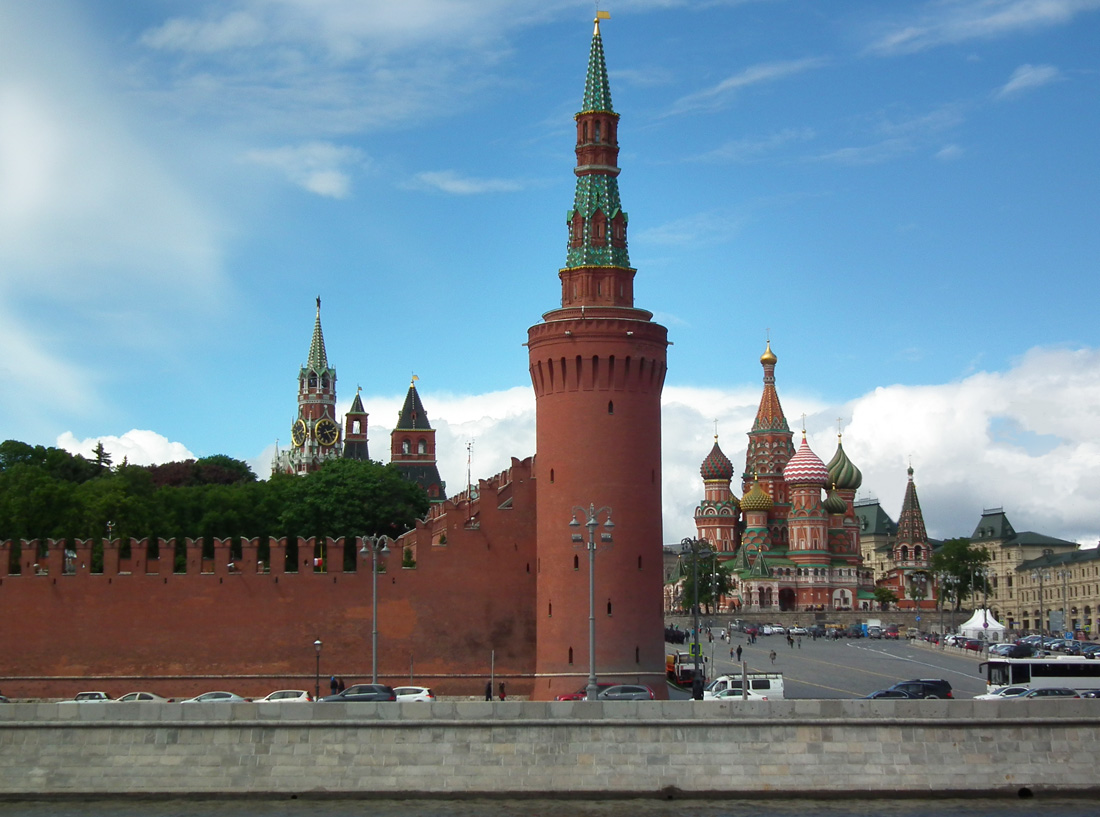 |
|||||
| A good place to begin our tour of Moscow.
In the centre of the photo, across the Moscow River, is the Western tower of the Kremlin walls. On the right we glimpse St Basil's Cathedral, which is in Red Square. |
Dmitri Donskoi replaced the oak walls with a strong citadel of white limestone in 1366–1368 on the basic foundations of the current walls;[4] this fortification withstood a siege by Khan Tokhtamysh. Dmitri's son Vasily I resumed construction of churches and cloisters in the Kremlin. The newly built Cathedral of the Annunciation was painted by Theophanes the Greek, Andrei Rublev, and Prokhor in 1406. The Chudov Monastery was founded by Dmitri's tutor, Metropolitan Alexis; while his widow, Eudoxia, established the Ascension Convent in 1397.
Grand Prince Ivan III organised the reconstruction of the Kremlin, inviting a number of skilled architects from Renaissance Italy, including Petrus Antonius Solarius, who designed the new Kremlin wall and its towers, and Marcus Ruffus who designed the new palace for the prince. It was during his reign that three extant cathedrals of the Kremlin, the Deposition Church, and the Palace of Facets were constructed. The highest building of the city and Muscovite Russia was the Ivan the Great Bell Tower, built in 1505–08 and augmented to its present height in 1600. The Kremlin walls as they now appear were built between 1485 and 1495. Spasskie gates of the wall still bear a dedication in Latin praising Petrus Antonius Solarius for the design. |
||||
| Wikipedia provides us with a brief history of the Kremlin:
"The site has been continuously inhabited by Finno-Ugric peoples since the 2nd century BC. The Slavs occupied the south-western portion of Borovitsky Hill as early as the 11th century, as evidenced by a metropolitan seal from the 1090s which was unearthed by Soviet archaeologists in the area. Vyatichi built a fortified structure (or "grad") on the hill where the Neglinnaya River flowed into the Moskva River. |
|||||
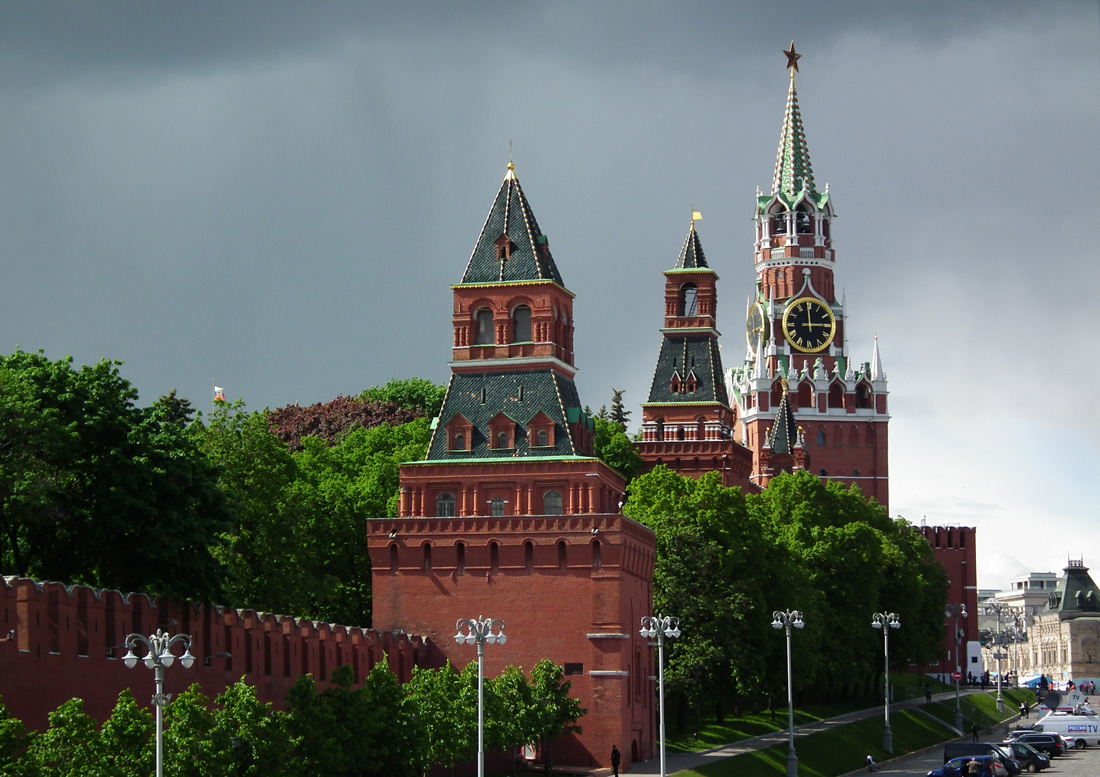 |
|||
| The tower with the clock is Spassky Tower. It faces Red Square.
It is worth noting that the name Red Square is a bit misleading. The Russian word "Krasnoye" has two meanings: it can mean red, but it can also mean beautiful. Originally, this was called the Beautiful Square, but the name Red Square caught on, especially during the Soviet era, for obvious reasons. |
|||
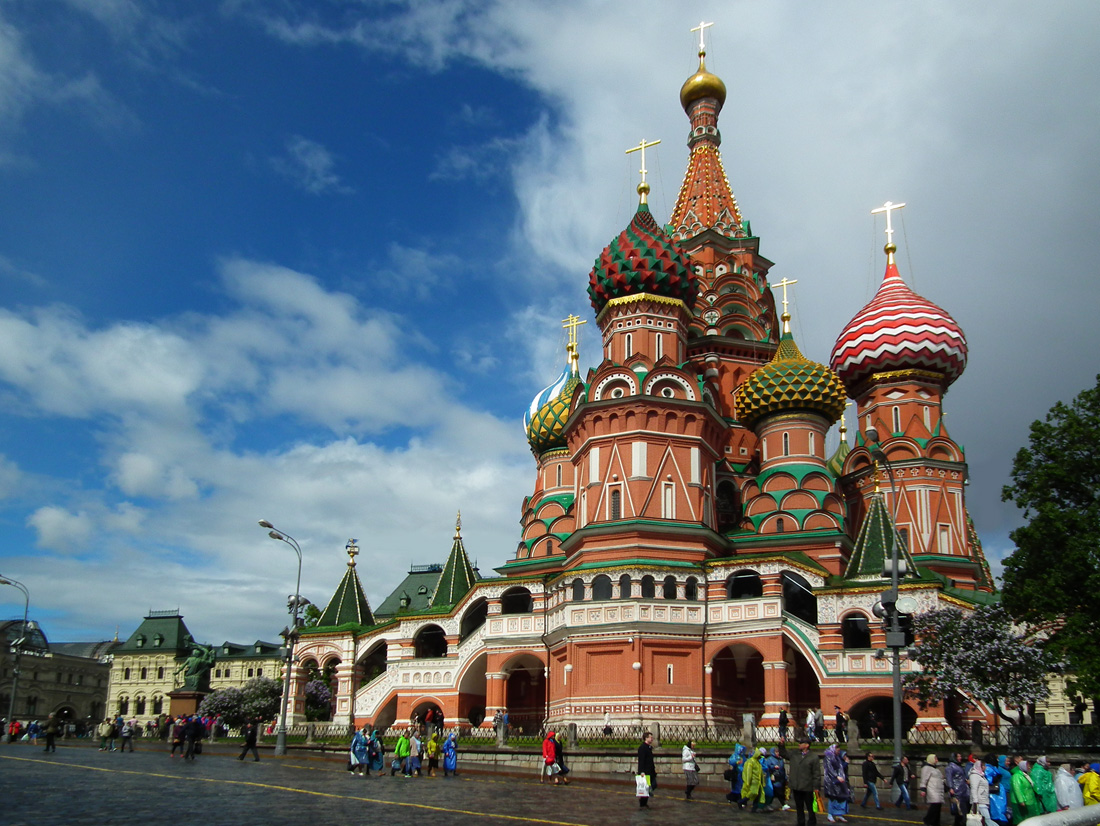 |
|||
| This is St Basil's Cathedral. It is probably the best known sight in the "Beautiful" Square. It was built from 1555-61 on the order of Ivan the Terrible (Ivan IV) to celebrate the capture from the Mongols of Kazan and Astrakhan.
It is worth mentioning that the name Ivan the Terrible is slightly misleading. His name in Russian is Ivan Grozny, which could be better translated as Ivan the Formidable (or Fearsome). In old English the word terrible had those extra meanings. |
|||
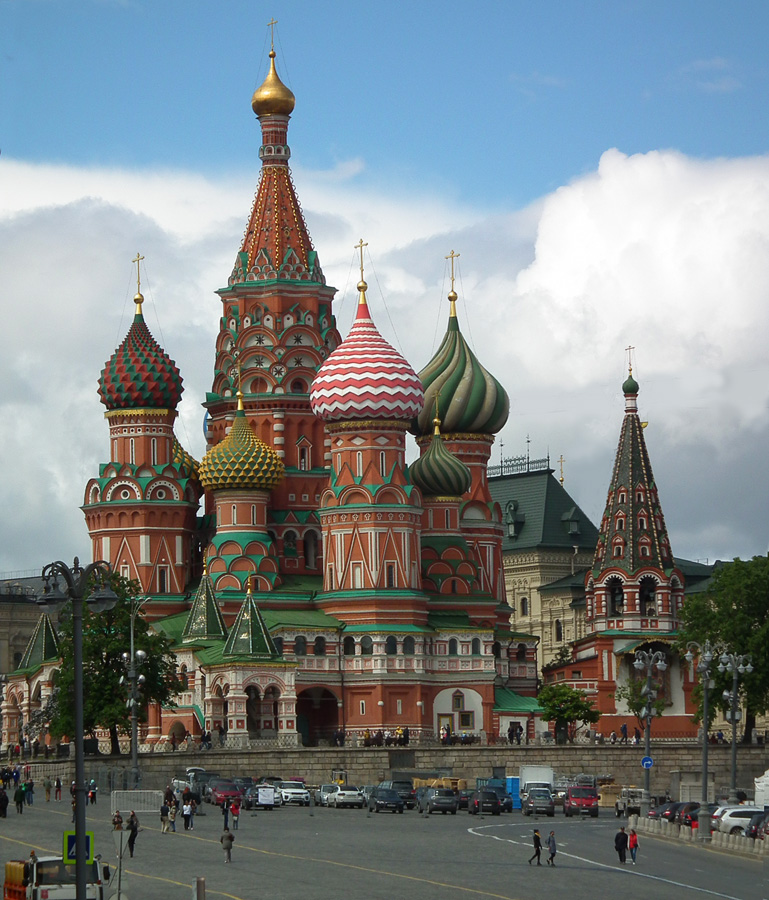 |
|||
| A different view of the Cathedral. | |||
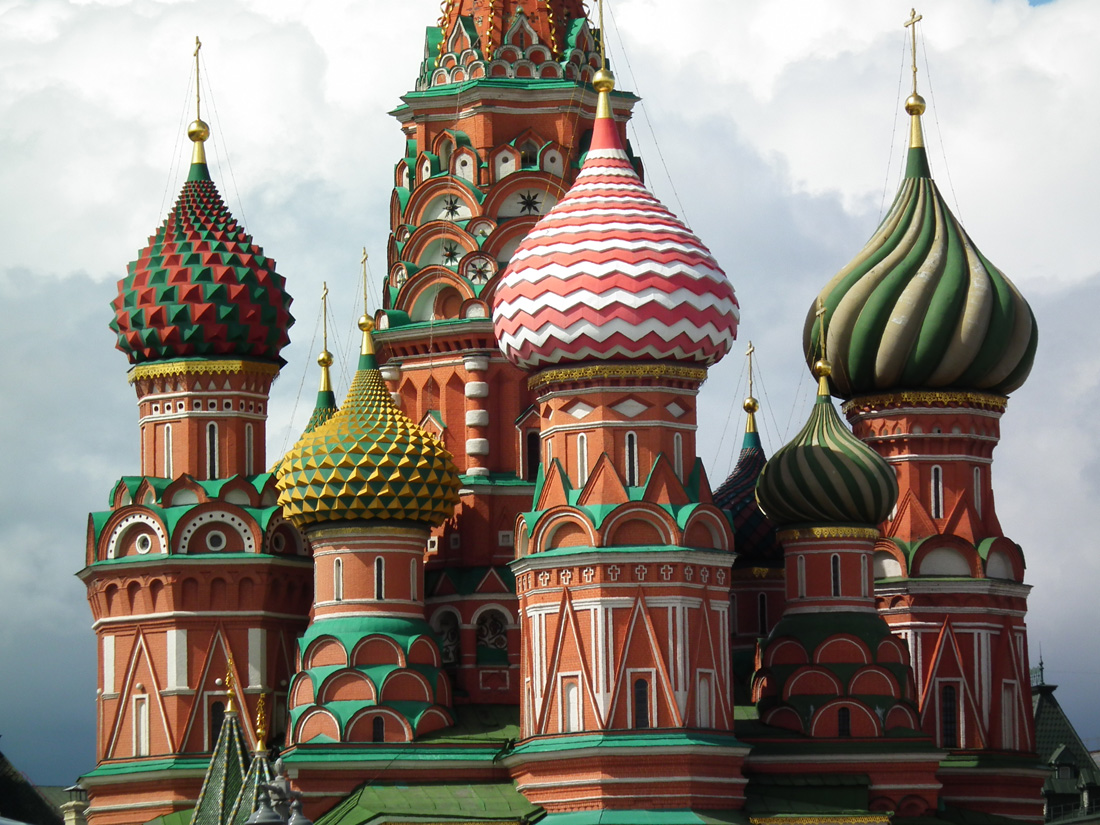 |
||
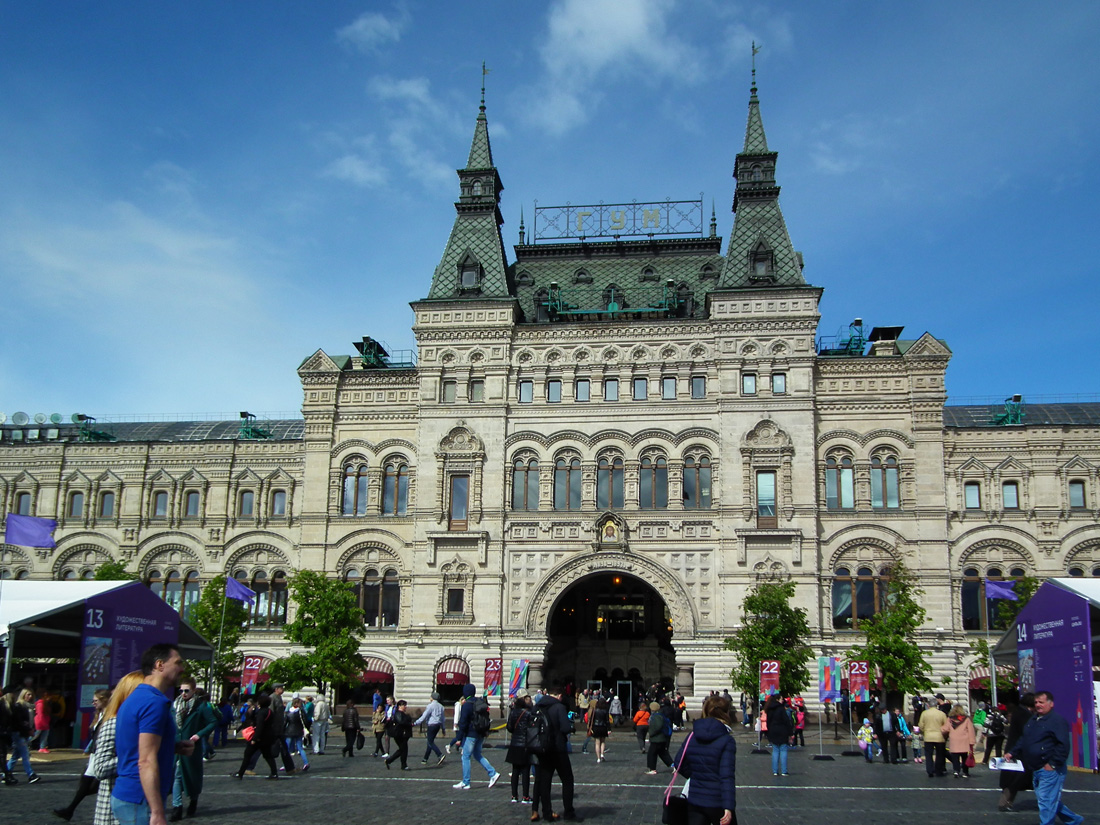 |
|||
| This is the famous GUM shopping mall. It faces South onto Red Square. | |||
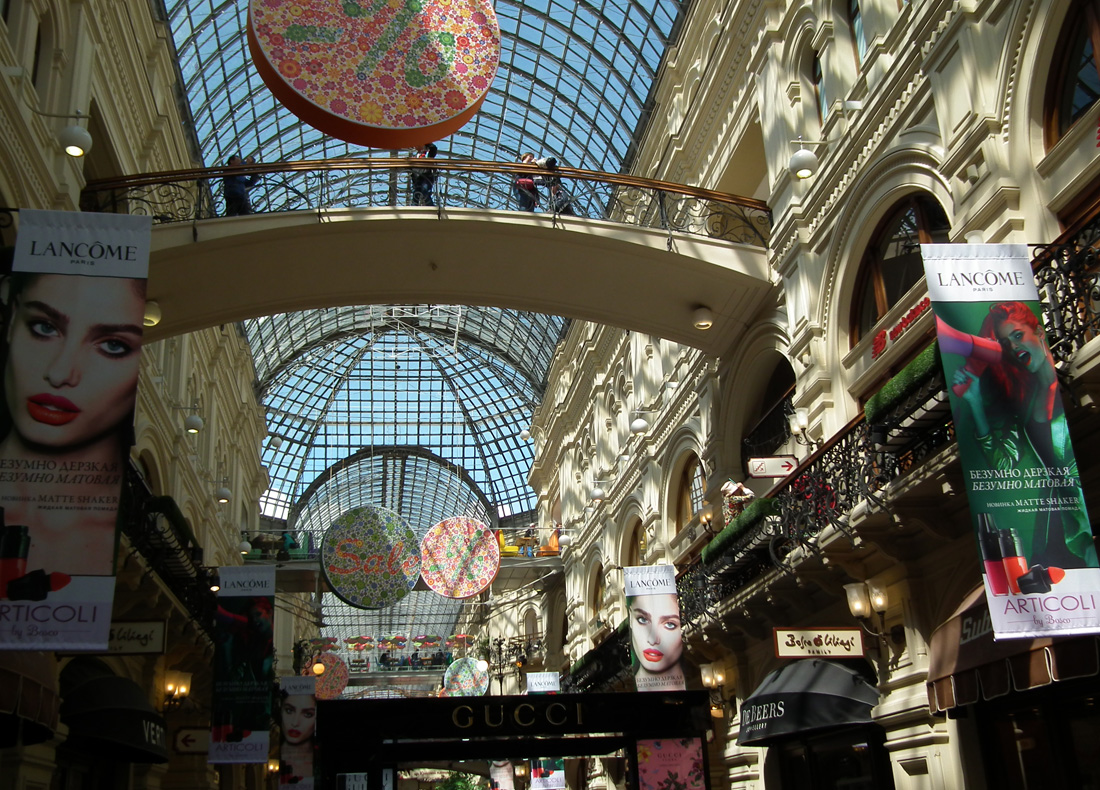 |
|||
| The interior of GUM. High end shops galore. My Muscovite friends tell me that the locals only come here to window shop, but the ice cream sold here is always popular. | |||
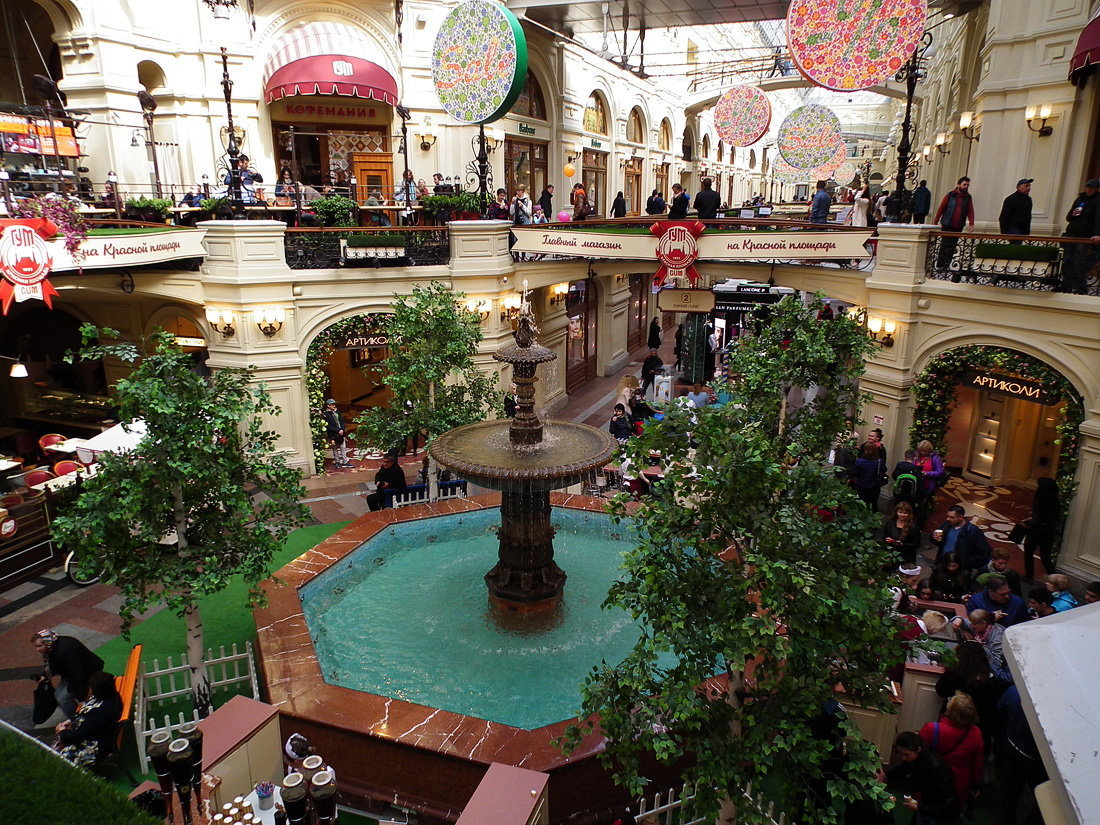 |
|||
| The name GUM is an abbreviation of Gosudarstvennyi Universalnyi Magazin (State Department Store). | |||
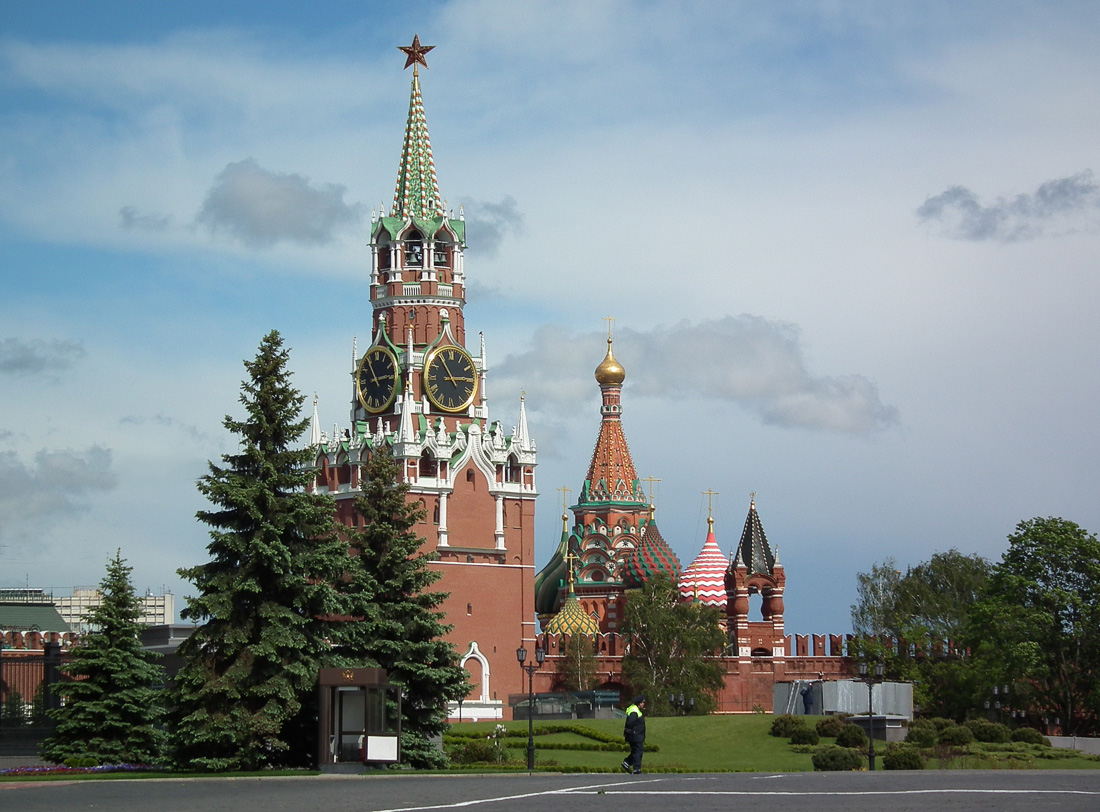 |
|||
| I joined a walking tour of the Kremlin. The guide was excellent. She was informative and amusing.
In this photo you can see the Spassky Tower and to its right, and beyond the walls of the Kremlin, you can see the spire and domes of St Basil's Cathedral. The word "Kremlin" simply means fortress in Russian. There are many Kremlins in towns and cities throughout Russia. Originally, the Moscow Kremlin was completely surrounded by water, and if you stood where Red Square is now, you would get more than your feet wet. |
|||
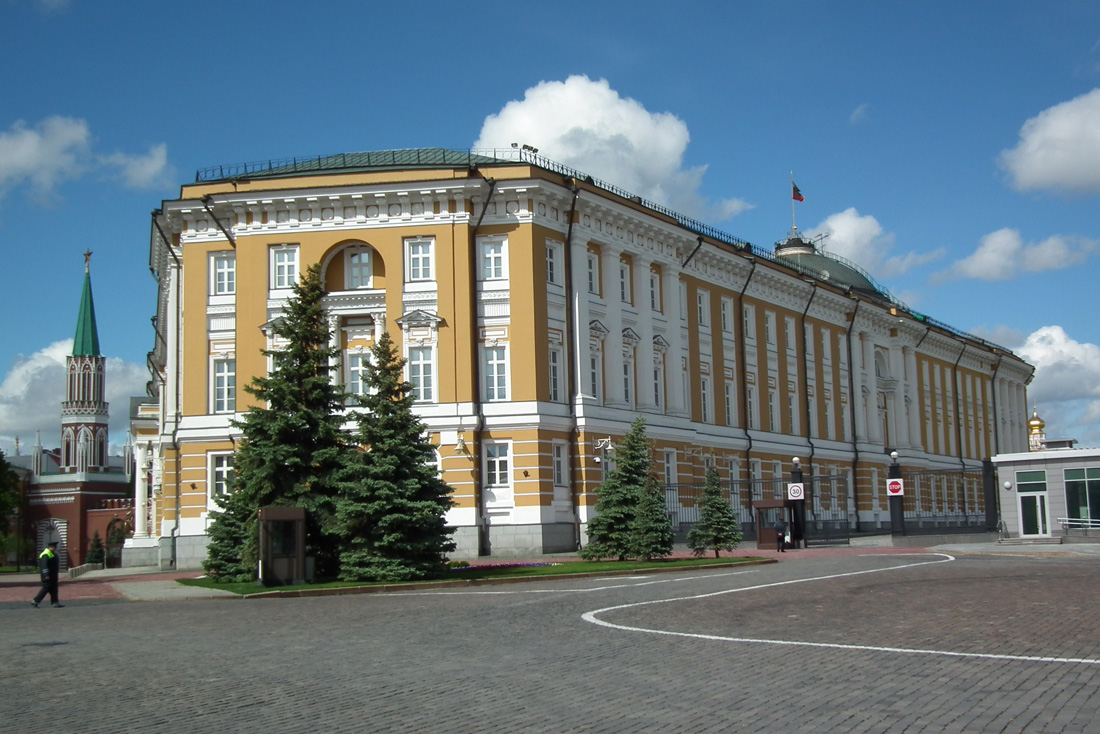 |
|||
| This is the Great Kremlin Palace which was built from 1837 to 1849. It became the official Moscow residence of the Tsars of Russia.
The Capital of Russia was St Petersburg since the time of Peter the Great. It was the Soviets who made Moscow the nation's capital once again. This building is now the official residence of the President of the Russian Federation. |
|||
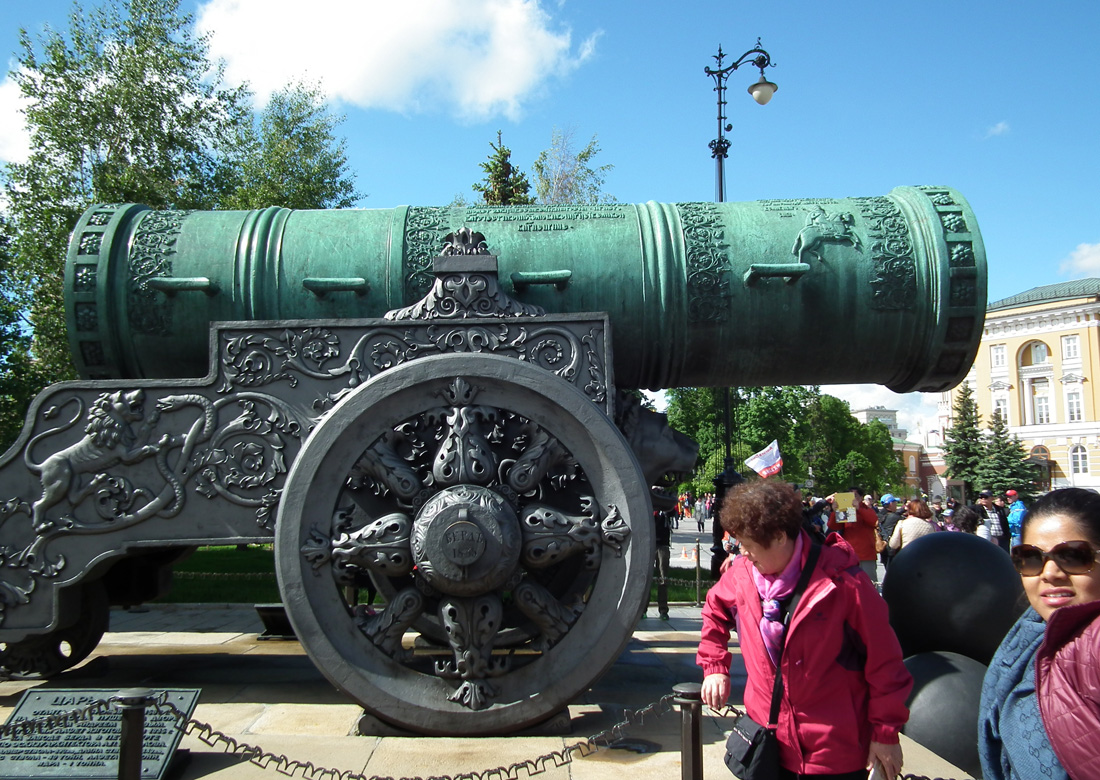 |
|||
| This is the Tsar Cannon, It was cast in bronze in 1586, and was never used in war. | |||
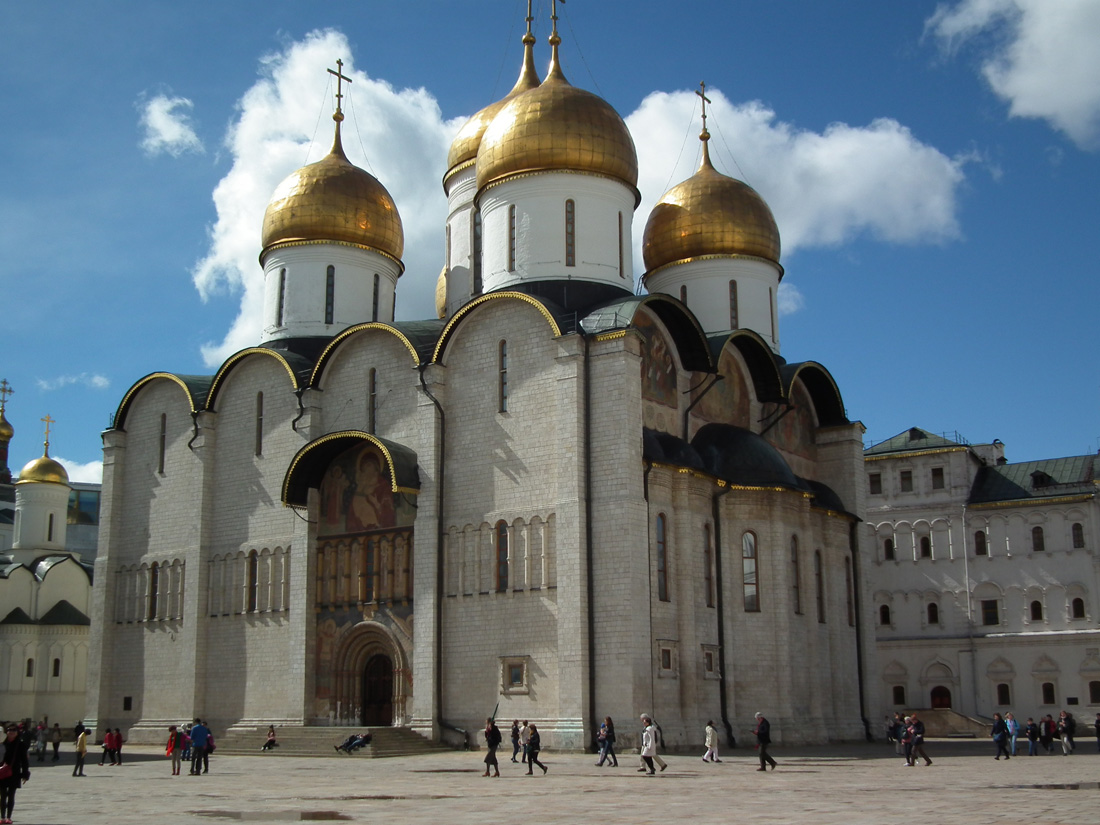 |
|||
| There are several churches within the Kremlin. This is the Dormition Cathedral.
Wikipedia explains: "The Cathedral of the Dormition, also known as the Assumption Cathedral or Cathedral of the Assumption is a Russian Orthodox church dedicated to the Dormition of the Theotokos. It is located on the north side of Cathedral Square of the Moscow Kremlin in Russia, where a narrow alley separates the north from the Patriarch's Palace with the Twelve Apostles Church. Southwest is Ivan the Great Bell Tower. Separately in the southwest, also separated by a narrow passage from the church, is the Palace of Facets. The Cathedral is regarded as the mother church of Muscovite Russia. In its present form it was constructed between 1475–79 at the behest of the Moscow Grand Duke Ivan III by the Italian architect Aristotele Fioravanti. From 1547 to 1896 it is where the Coronation of the Russian monarch was held. In addition, it is the burial place for most of the Moscow Metropolitans and Patriarchs of the Russian Orthodox Church. |
|||
 |
|||
| The Church of the Nativity. It is one of the smaller domestic churches within the Kremlin walls. | |||
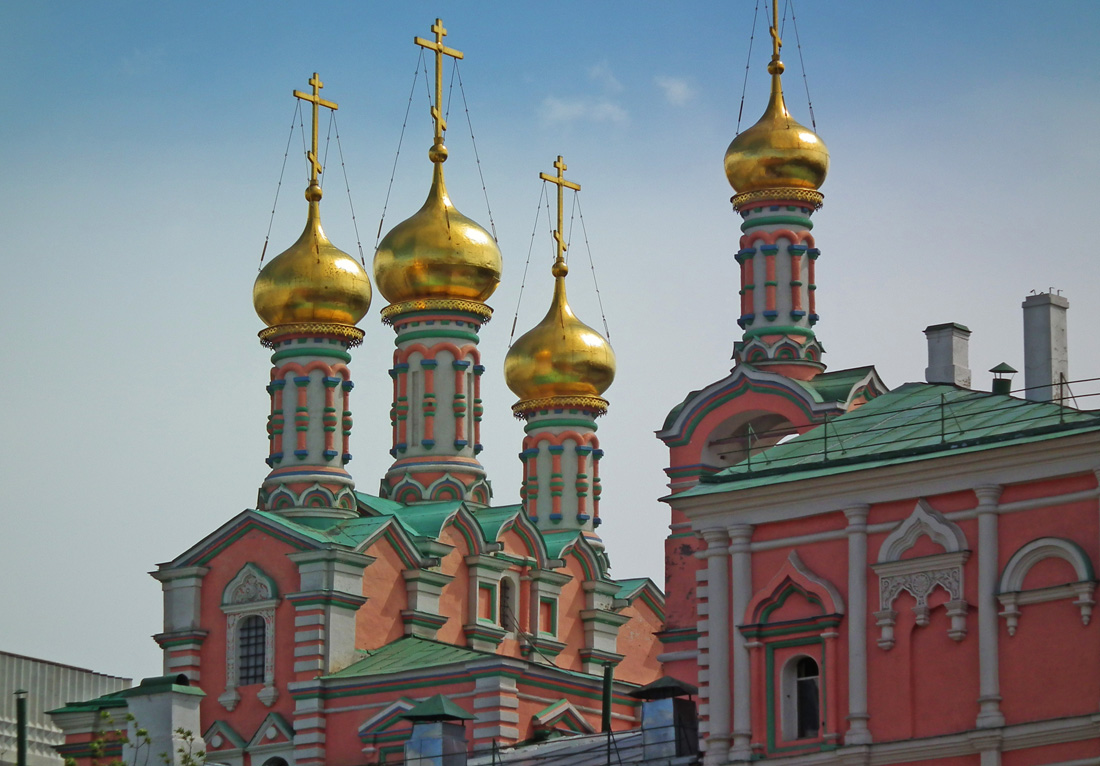 |
|||
| I couldn't discover the name of this church within the Kremlin. If anyone knows the answer to this riddle, please get in touch with me! | |||
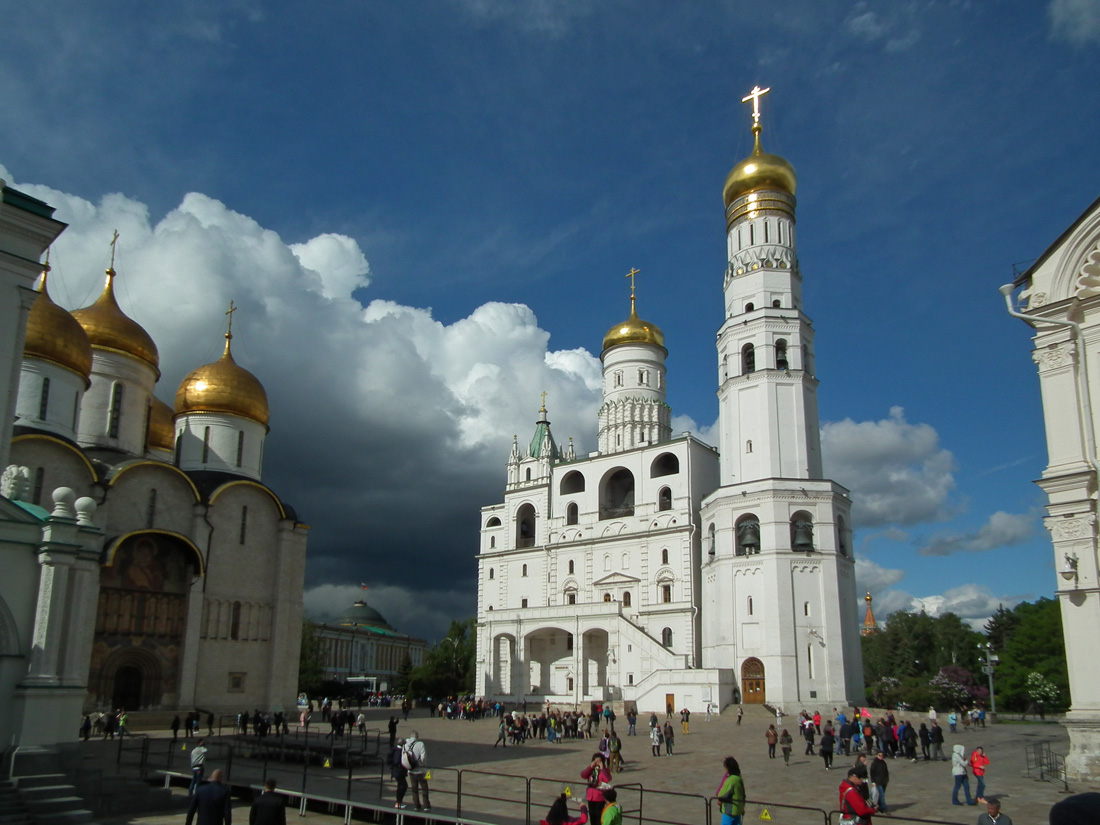 |
|||
| The tall white structure is the Ivan the Great Bell Tower. It was completed in 1508.
Wikipedia states: "Until the building of the Cathedral of Christ the Saviour in 1883, it was the tallest building in old Moscow, and it was forbidden to put up any building in Moscow which was taller than the Bell Tower." |
|||
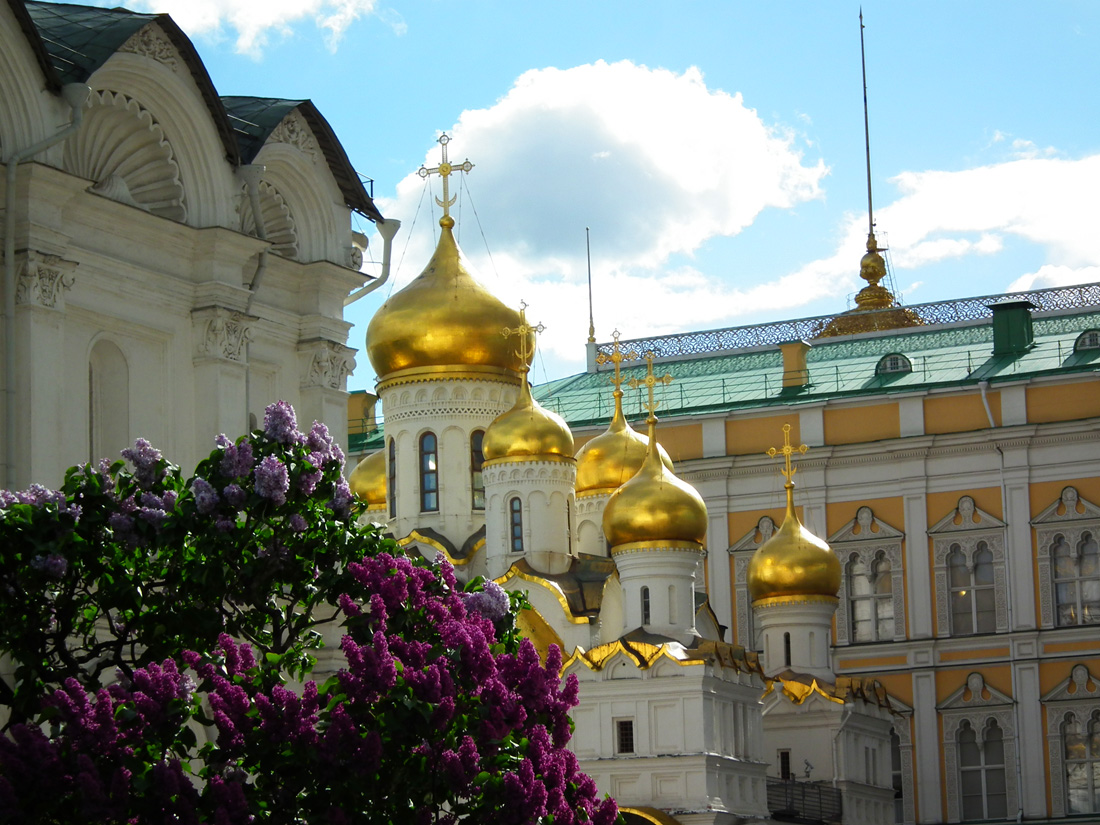 |
||
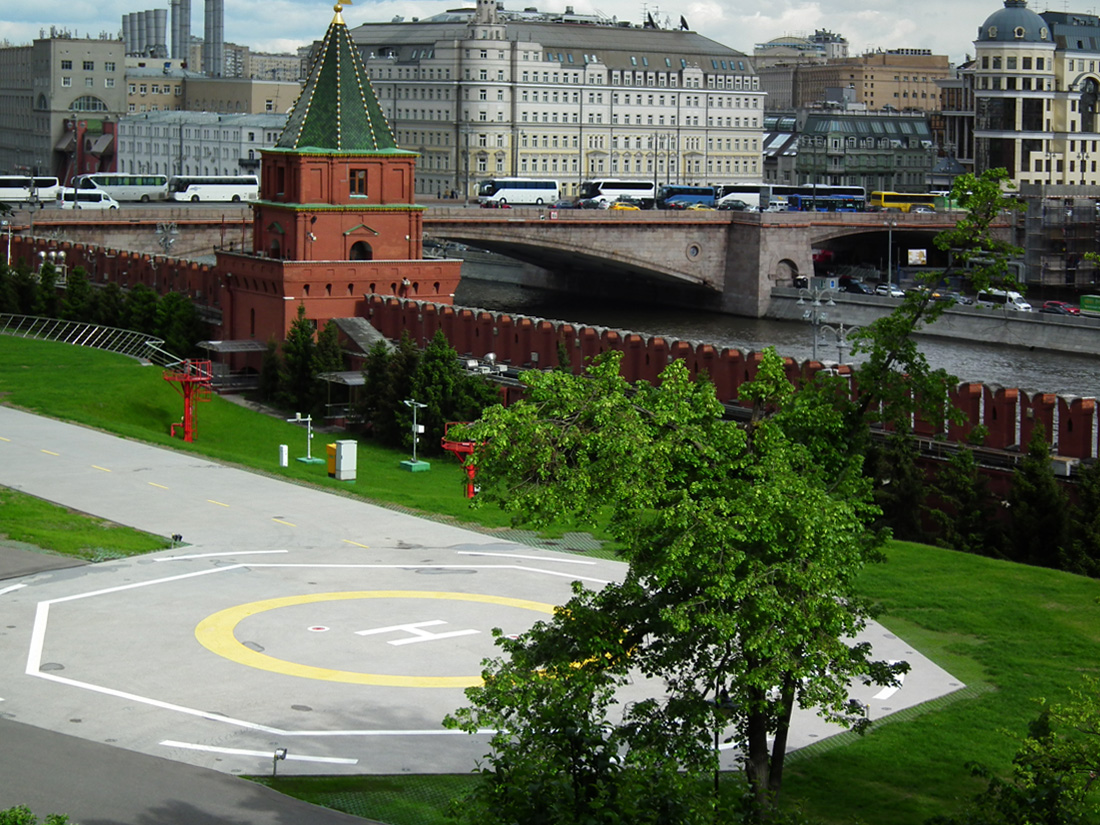 |
|||
| This is the helicopter landing pad for "you know whotin". | |||
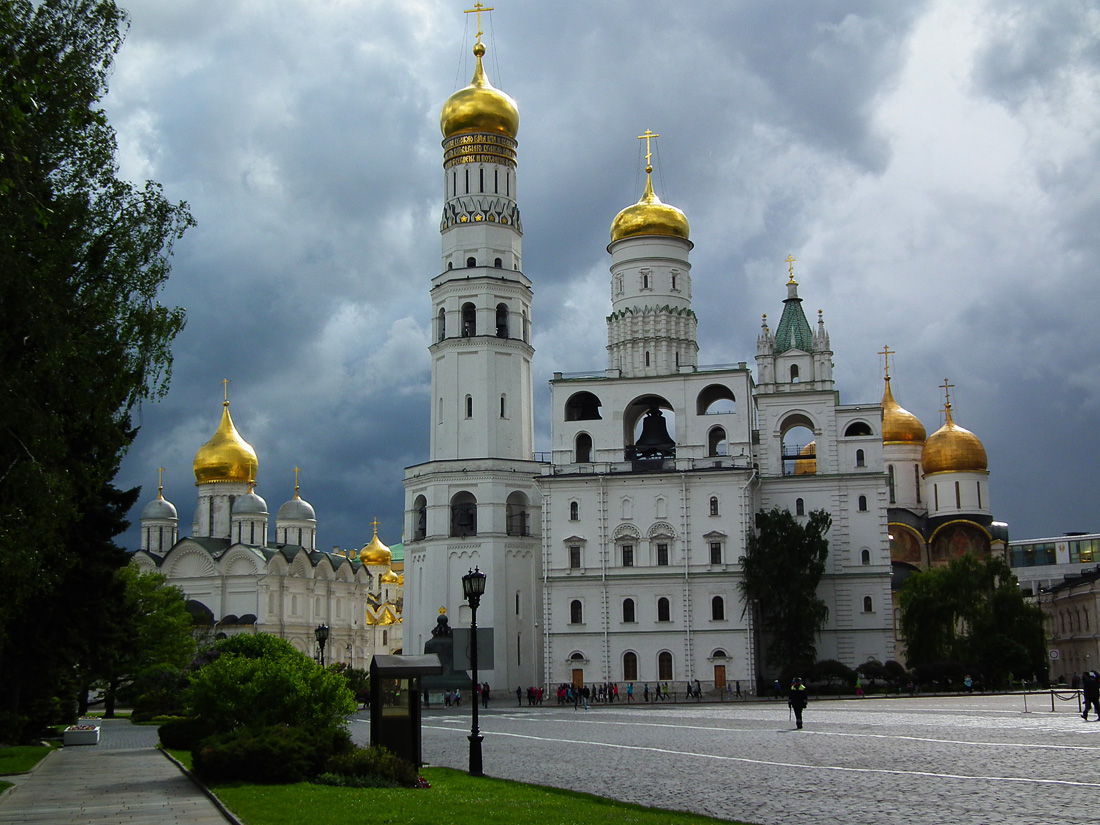 |
|||
| Another view of the Ivan the Great Bell Tower. The great bell is clearly visible from this angle. | |||
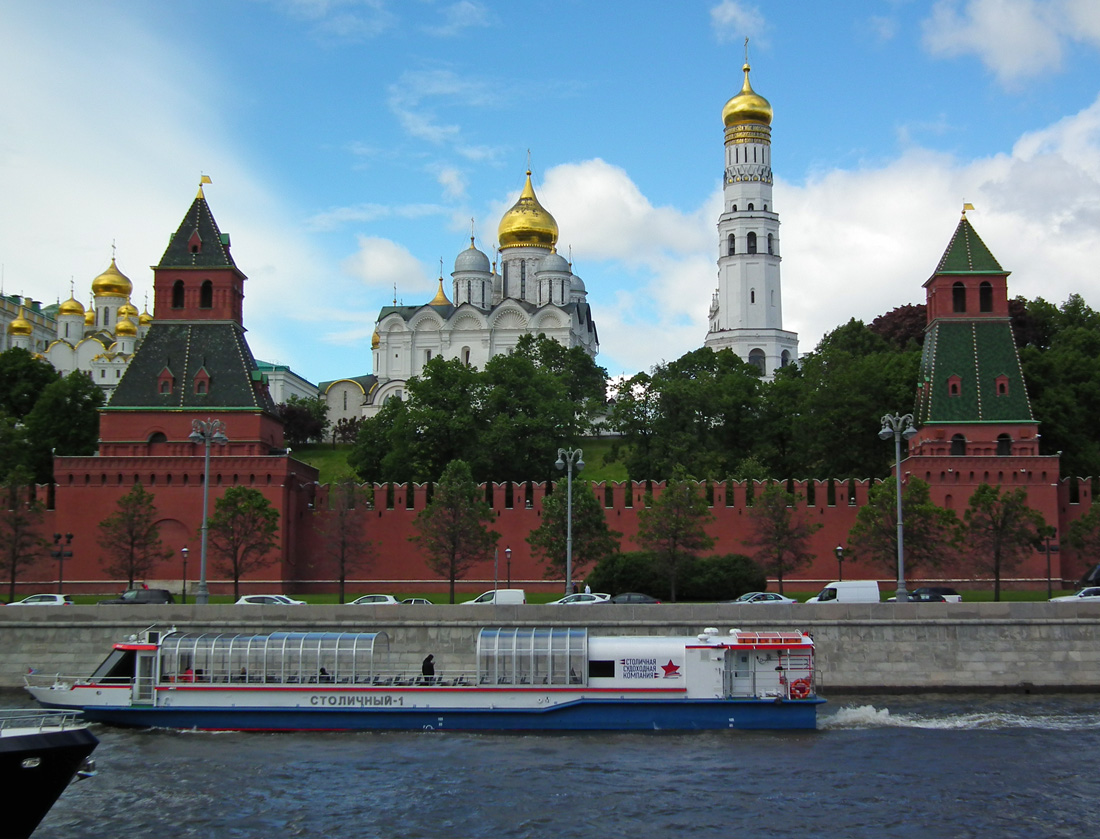 |
|||
| We wave goodbye to the Kremlin from across the Moscow River. | |||
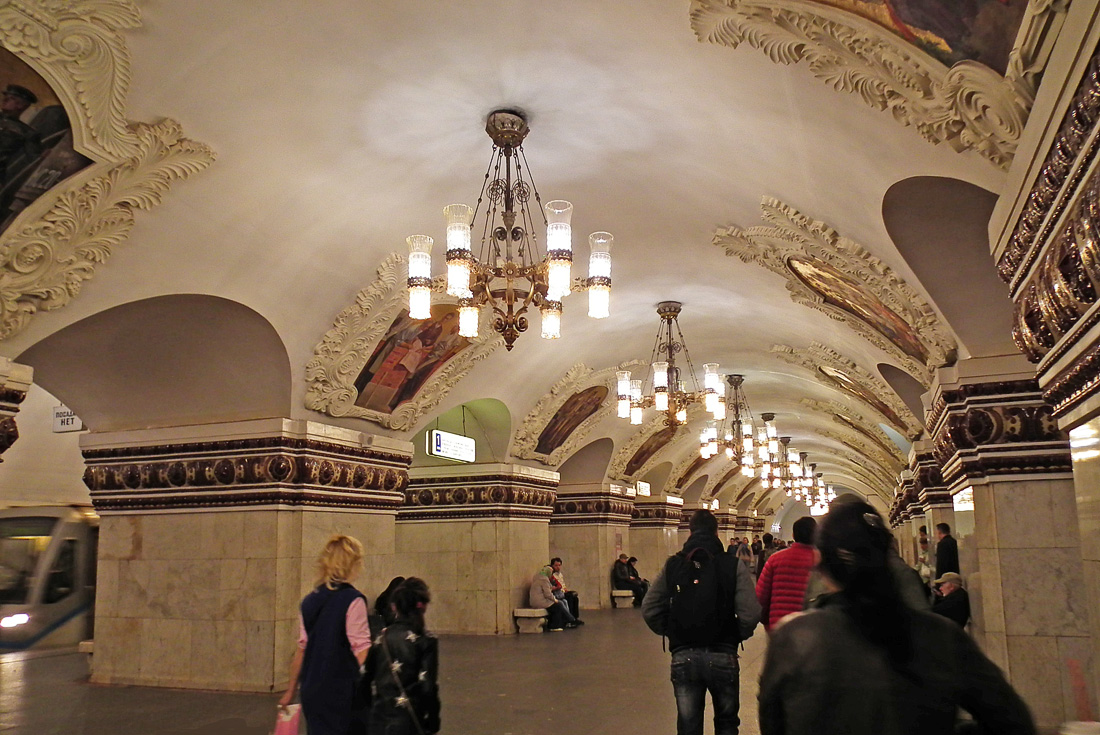 |
|||
| The Moscow Metro must surely be one of the most glamorous in the world. Many of the stations are lavishly decorated.
There are many lines criss-crossing the city and it is the best way to get from A to B. The tickets are very reasonably priced. For about a US dollar you can travel one stop or ten. |
|||
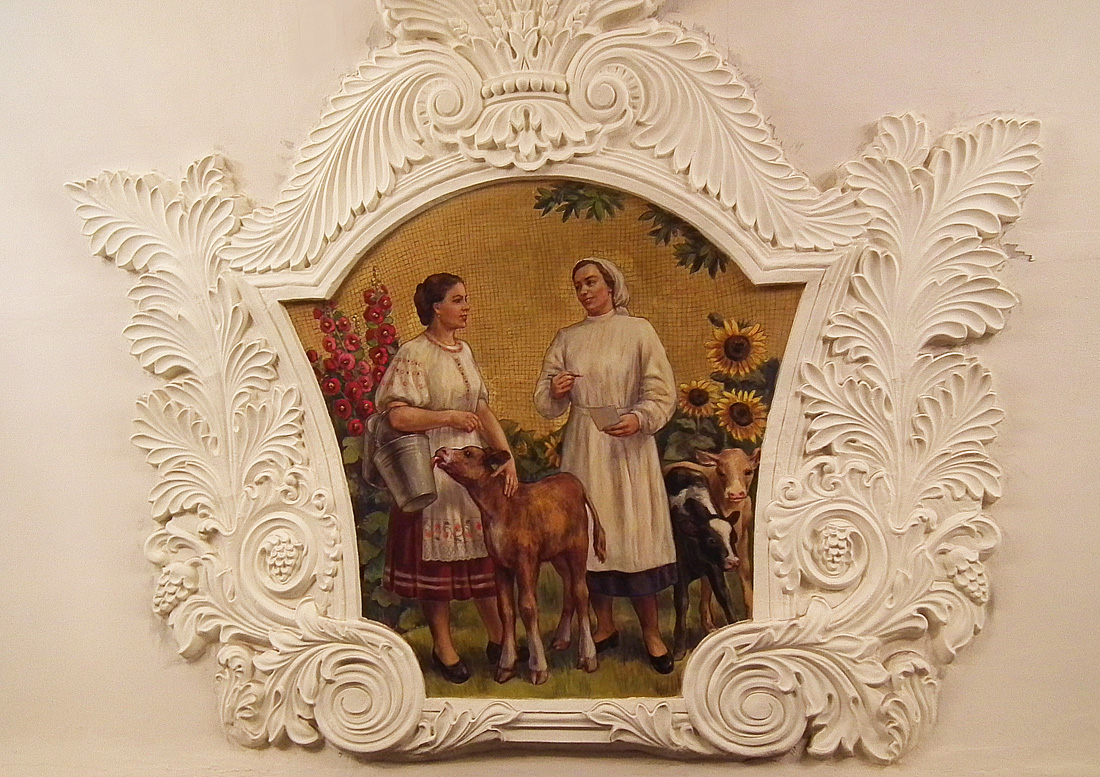 |
|||
| This mosaic is in the Kievskaya Station on the Metro. | |||
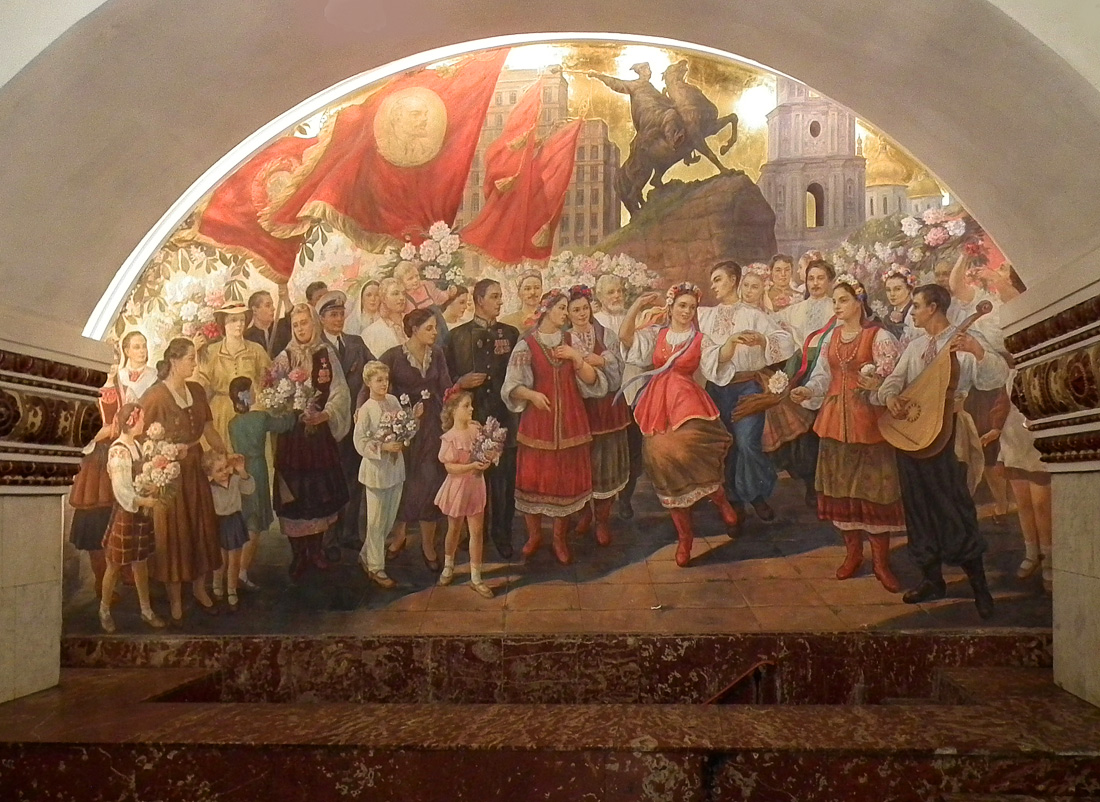 |
||
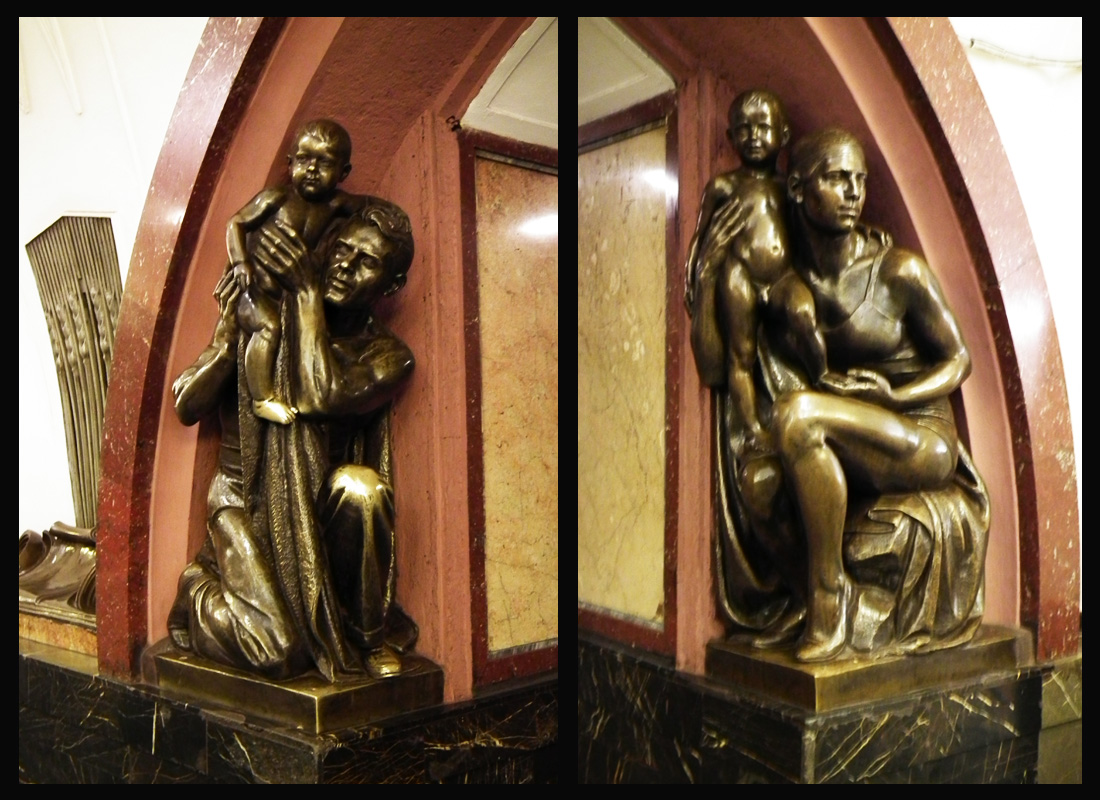 |
|||
| These two bronzes are in the Revolution Square Station (Ploshchad Revolyutsii). | |||
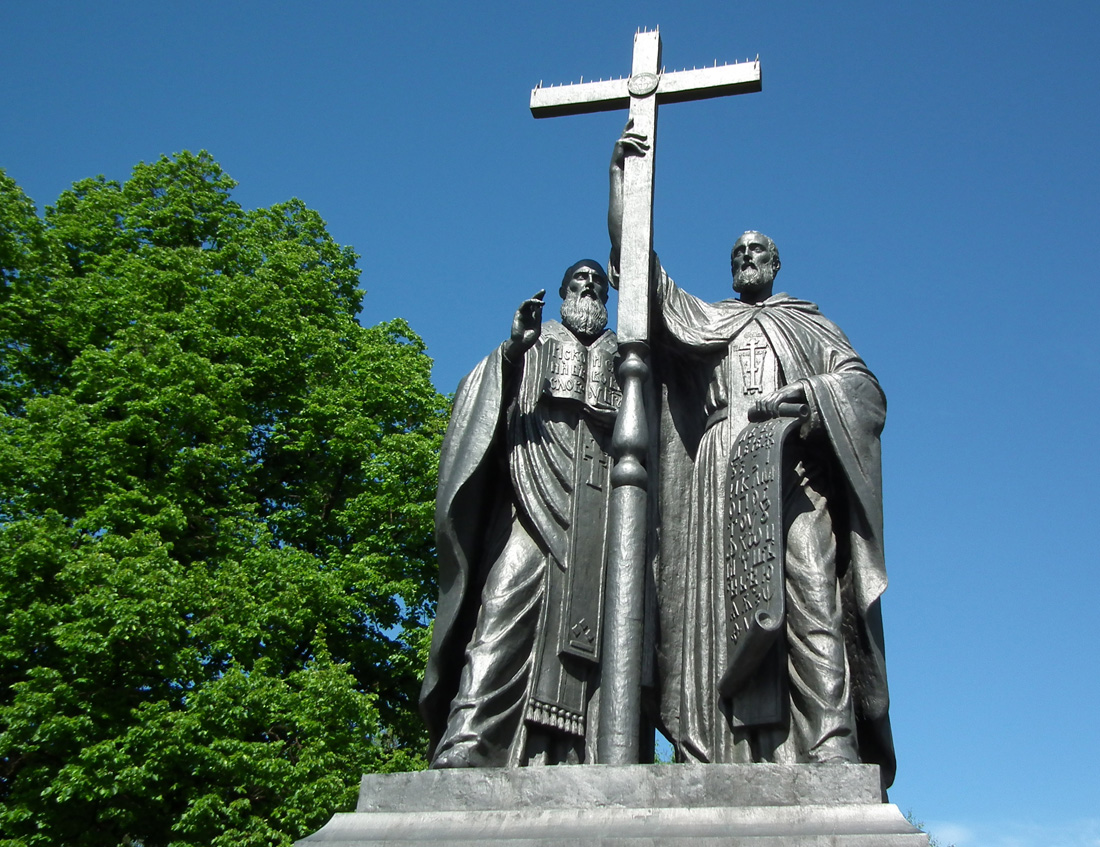 |
|||
| This double statue commemorates Saints Cyril and his brother, Methodius. They were responsible for borrowing heavily from the Greeks and creating the first Slavic alphabet, now known as Cyrillic.
On one of the walking tours I joined, a Greek woman jokingly complained that, as a Greek speaker, she could only understand half of the Russian script. Luckily for me, when I was a kid in Hong Kong, my brother and I were taught Russian by a proverbial Little Old Lady. She did a great job as I was surprised how much Russian I still remembered from way back then. (And believe me, that was a very long time ago!). When I was in Russia, people I talked to would often remark that, while my vocabulary wasn't much good, I spoke Russian "without an accent". I took that as a compliment to the powers of that Little Old Russian Lady who taught us. |
|||
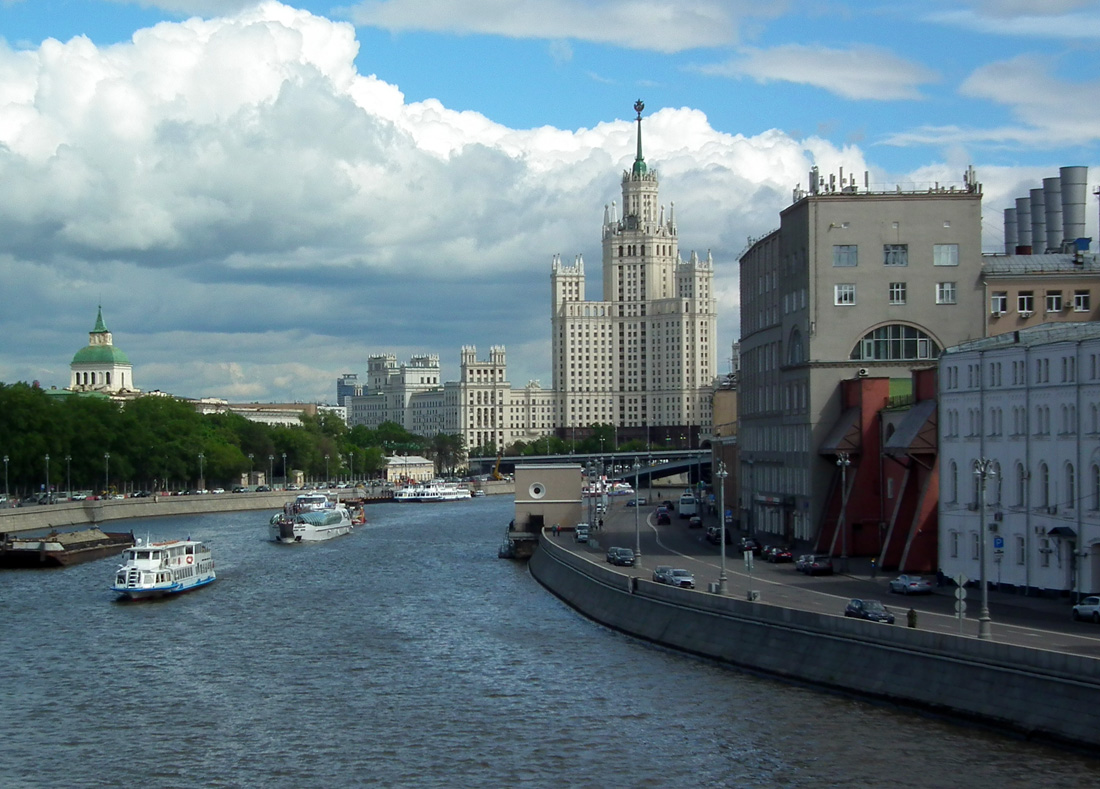 |
|||
| A view of the Moscow River with one of Stalin's Socialist Realist Palaces in the distance. There are seven of them in Moscow, and the locals call them the Seven Sisters. | |||
| This is the monument to Vladimir the Great, also known as St Vladimir of Kiev (958-1015). He is accredited for converting the Russians from Paganism to Christianity.
Wikipedia has this amusing account of why Vladimir chose to convert Russia specifically to the Greek Byzantine Orthodox Faith: "The Primary Chronicle reports that in the year 987, after consultation with his boyars, Vladimir the Great sent envoys to study the religions of the various neighboring nations whose representatives had been urging him to embrace their respective faiths. The result is described by the chronicler Nestor. Of the Muslim Bulgarians of the Volga the envoys reported there is no gladness among them, only sorrow and a great stench. He also reported that Islam was undesirable due to its taboo against alcoholic beverages and pork. Vladimir remarked on the occasion: "Drinking is the joy of all Rus'. We cannot exist without that pleasure." Ukrainian and Russian sources also describe Vladimir consulting with Jewish envoys and questioning them about their religion, but ultimately rejecting it as well, saying that their loss of Jerusalem was evidence that they had been abandoned by God. |
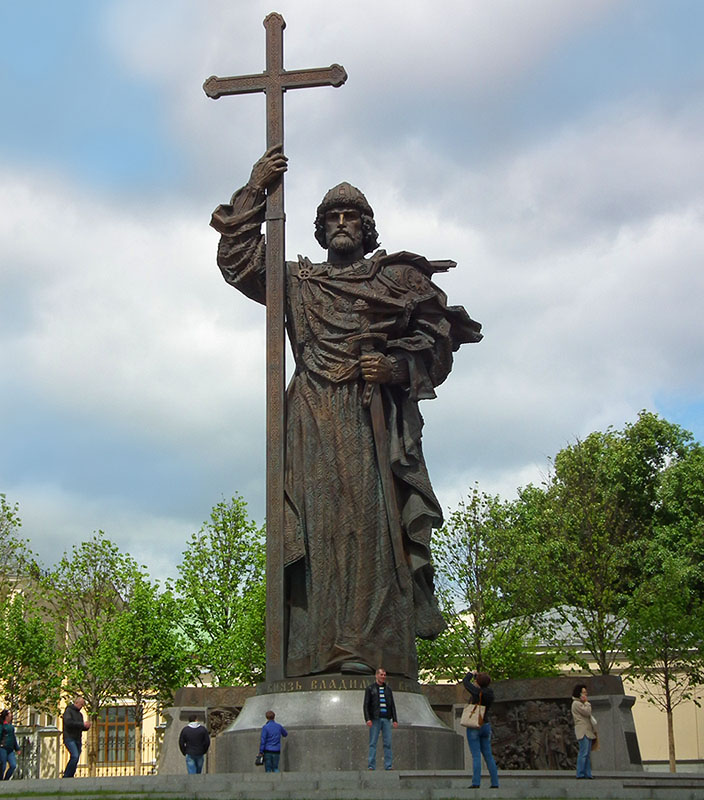 |
|||
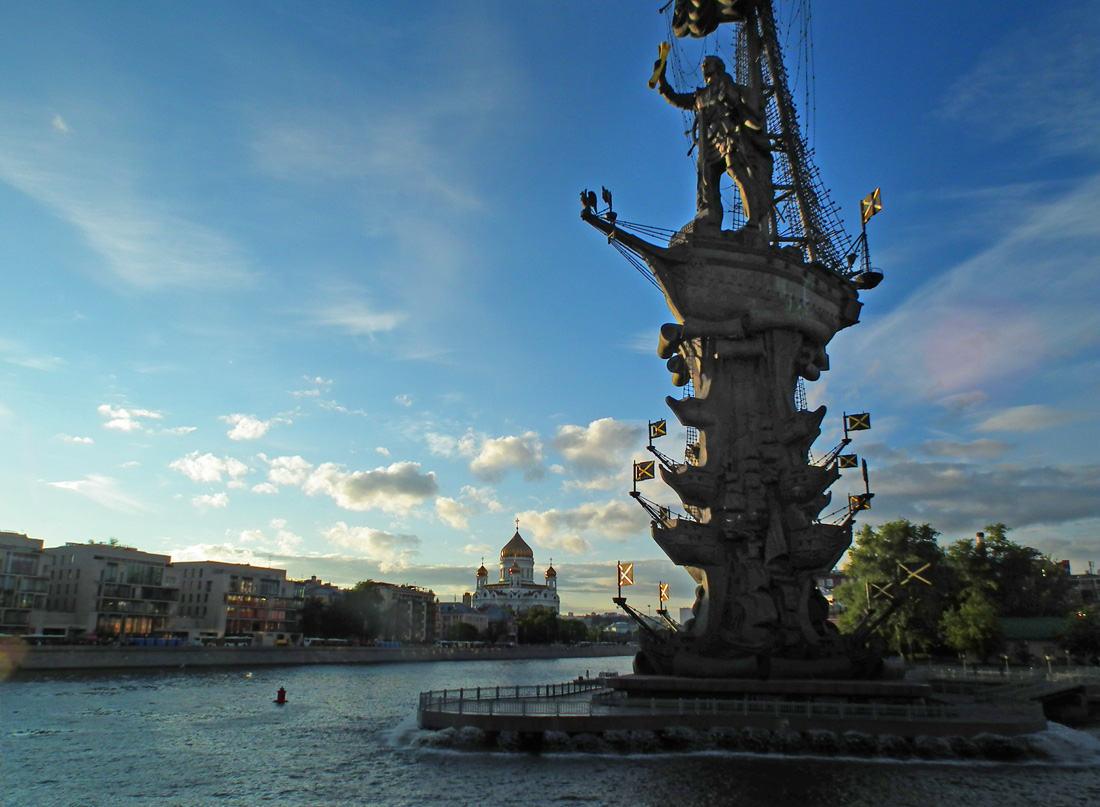 |
|||
| This is a huge memorial to Peter the Great. Muscovites have a love-hate relationship with Peter as he was responsible for moving his Capital from Moscow to St Petersburg. Apparently, some Muscovites are not too fond of this giant memorial either. | |||
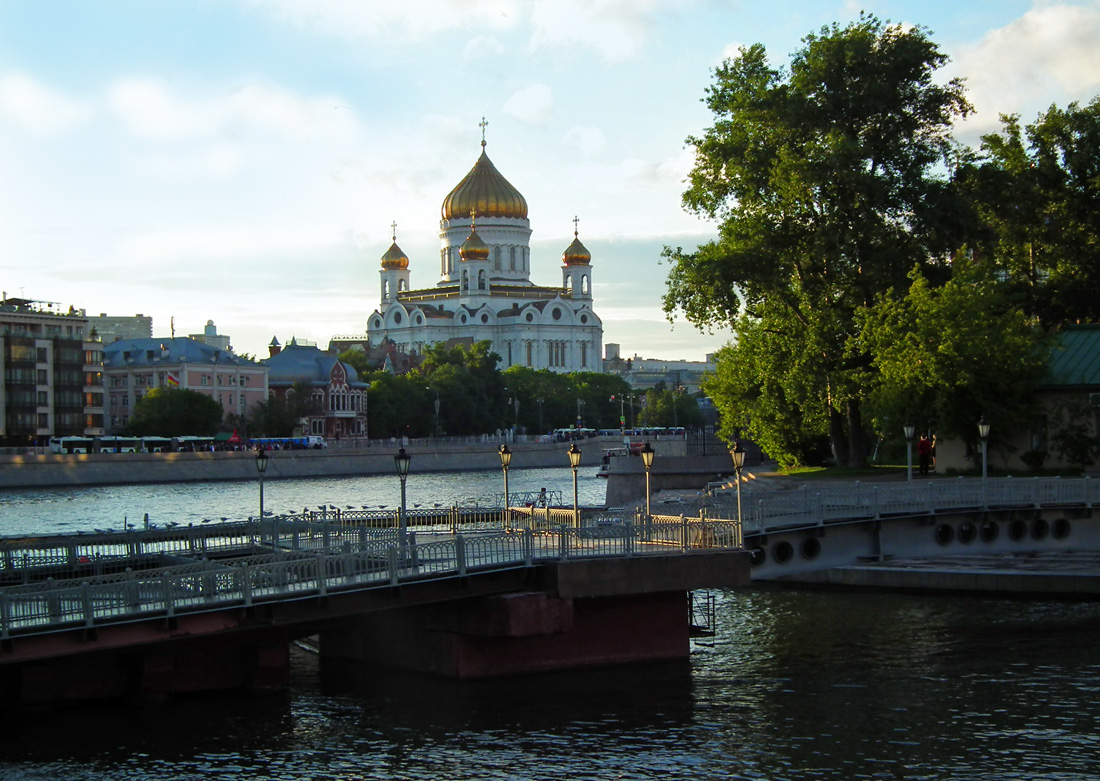 |
|||
| Across the river from Peter's memorial we see the Cathedral of Christ the Saviour. The original building was demolished in 1931 on Stalin's orders and was supposed to be replaced by a giant Palace of the Soviets.
The present Cathedral was built from 1995 to 2000. About a million Muscovites donated money for the reconstruction. |
|||
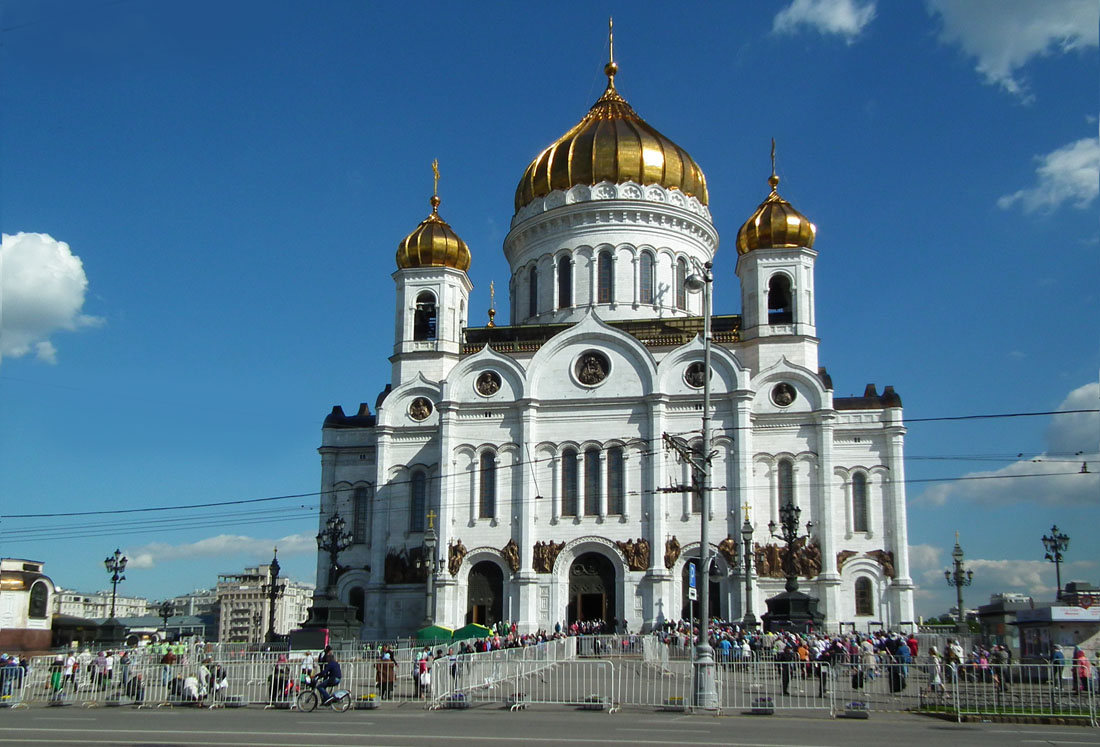 |
|||
| As I mentioned earlier, about a million Muscovites donated money to the reconstruction of this Cathedral. In spite of many decades of Soviet rule, and vicious anti-religious propaganda, I found that most of the people I spoke to on my visit to Russia said that they were Orthodox Christians who went to Church regularly.
t seems to be the case that, when movements are forced underground, they often emerge from a period of repression stronger than ever. |
|||
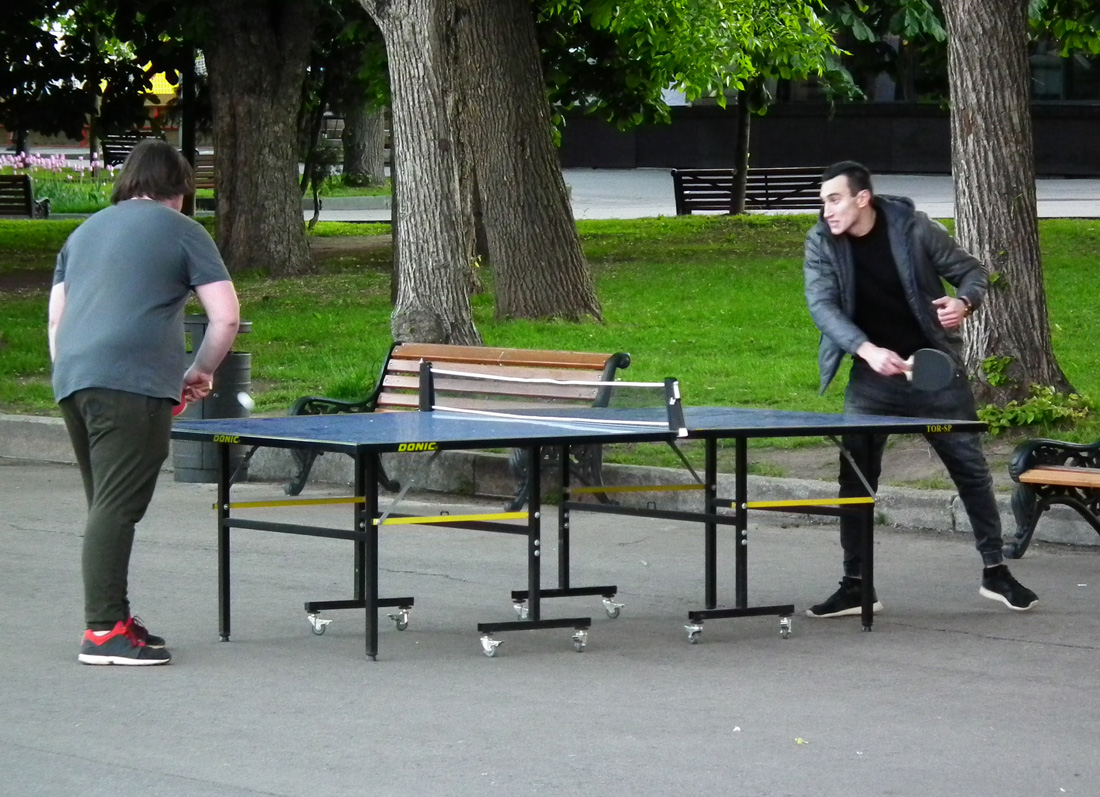 |
|||
| Just downriver from the Peter Memorial, we come across Gorky Park. Here a couple of ping pong players are doing their thing. | |||
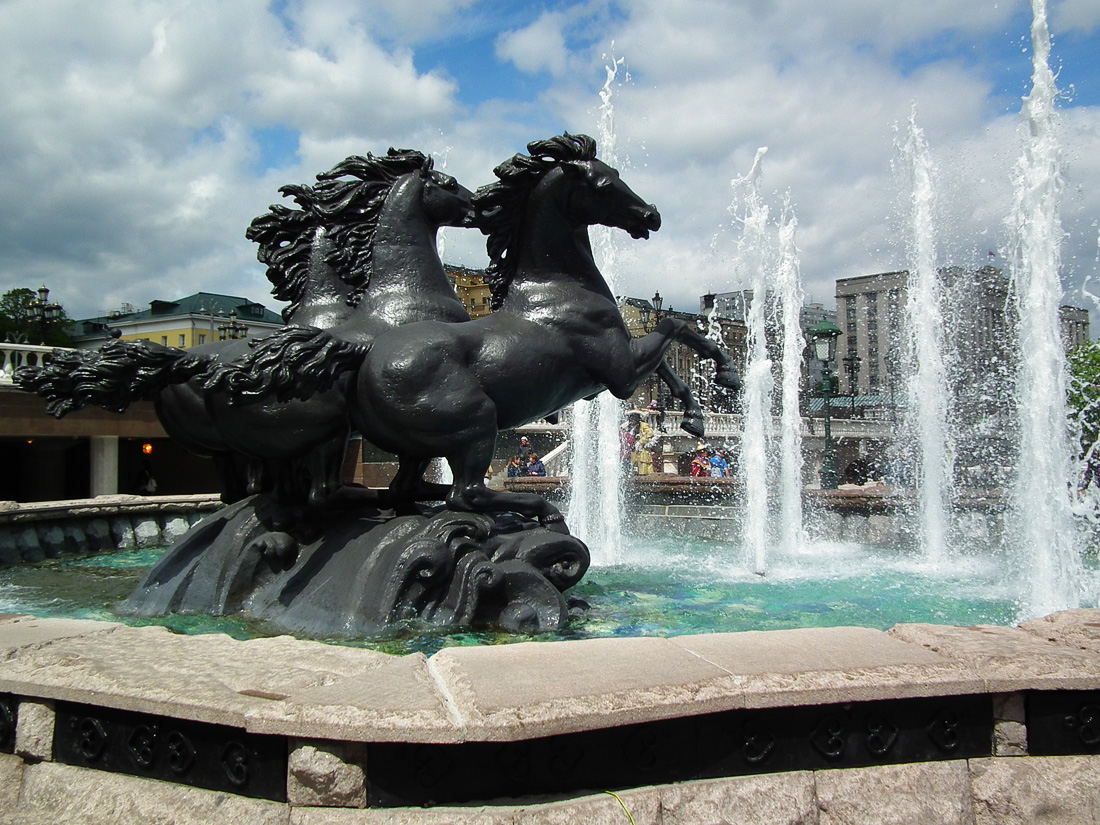 |
|||
| These prancing horses are in a park close to the Kremlin. | |||
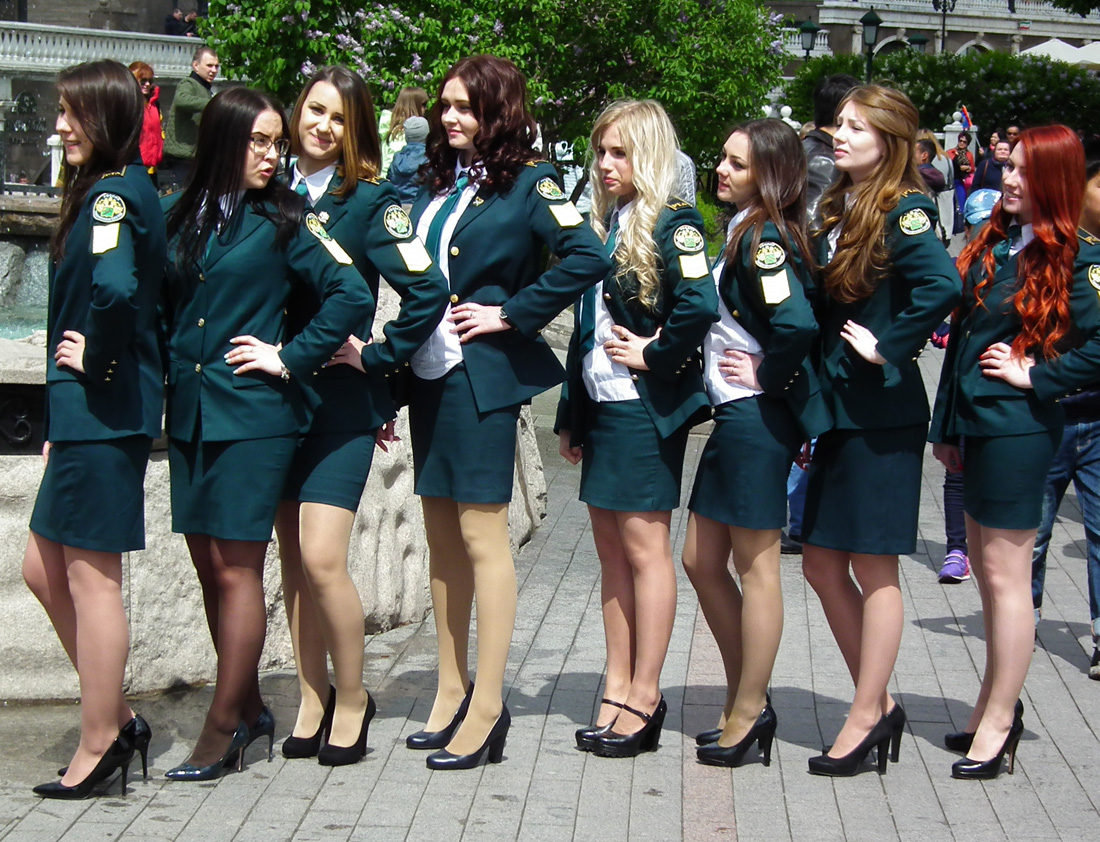 |
|||
| And next to the prancing horses, I saw these lovely Russian women. | |||
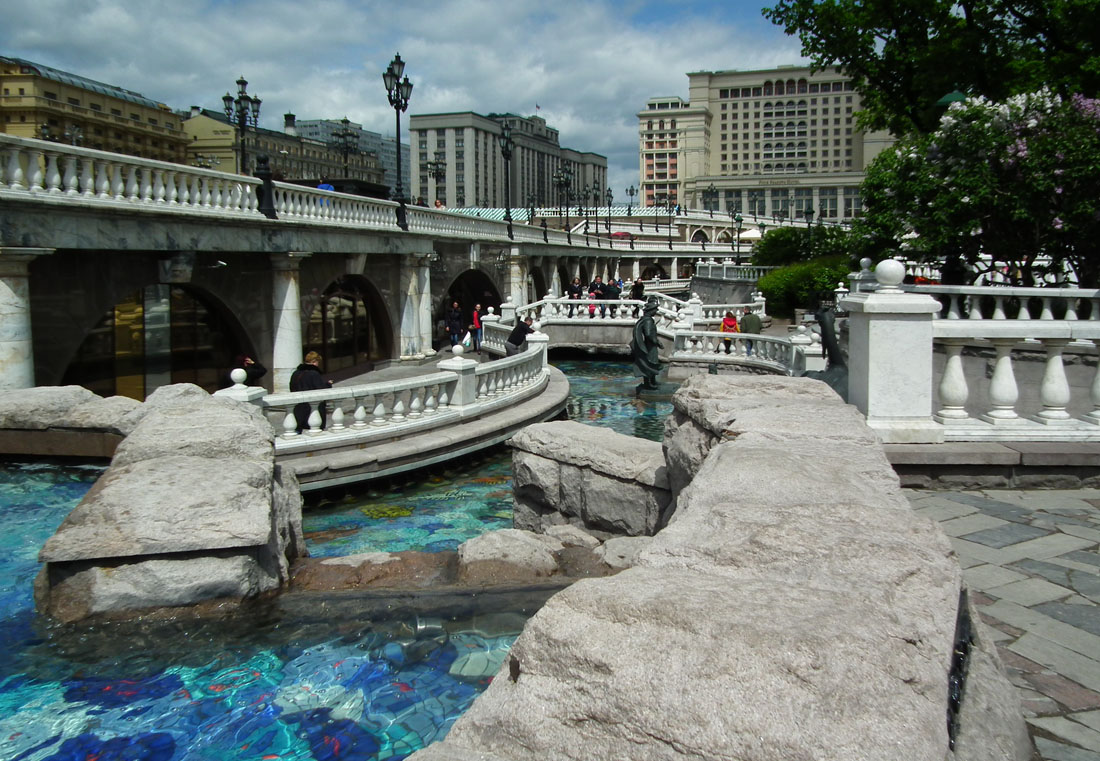 |
||
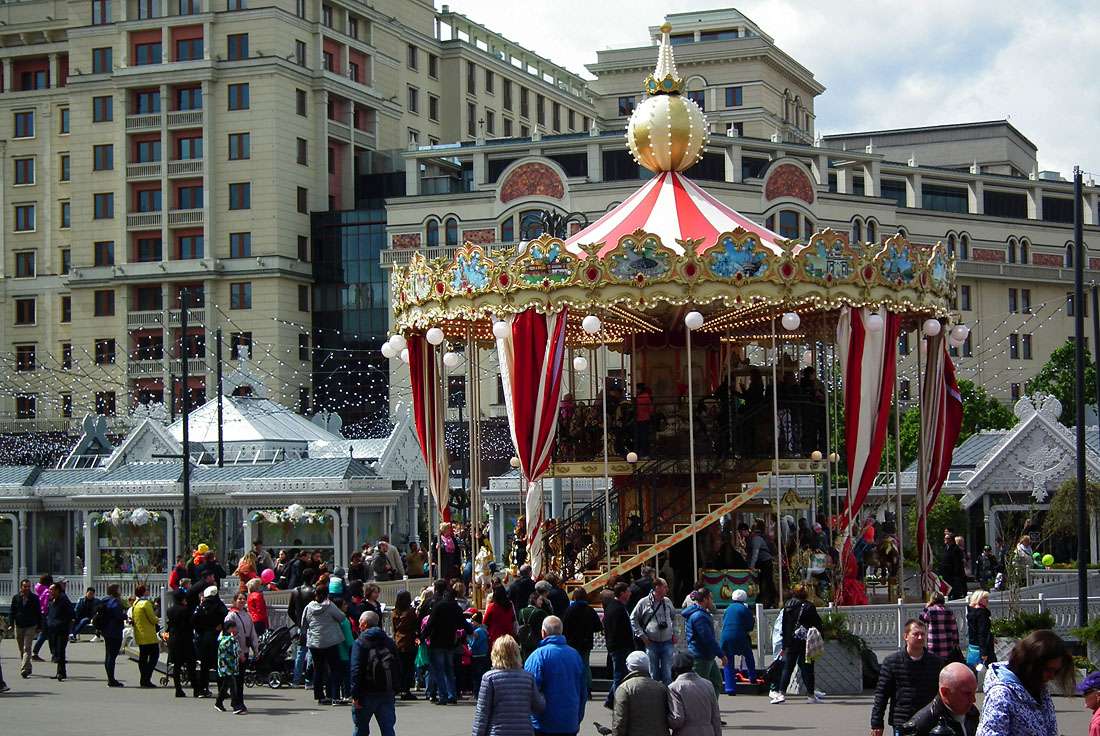 |
||
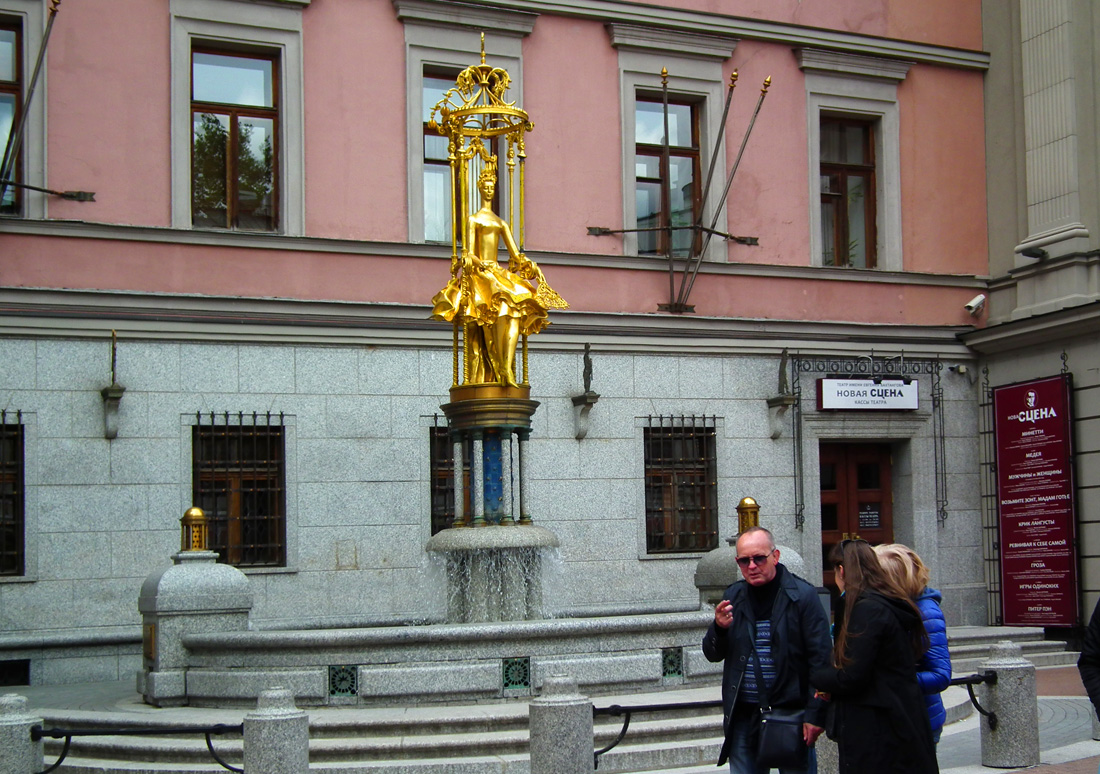 |
|||
| The next four photos are of Old Arbat Street. This used to be an area which attracted many writers and artists, including Pushkin. It is now a pedestrian precinct. | |||
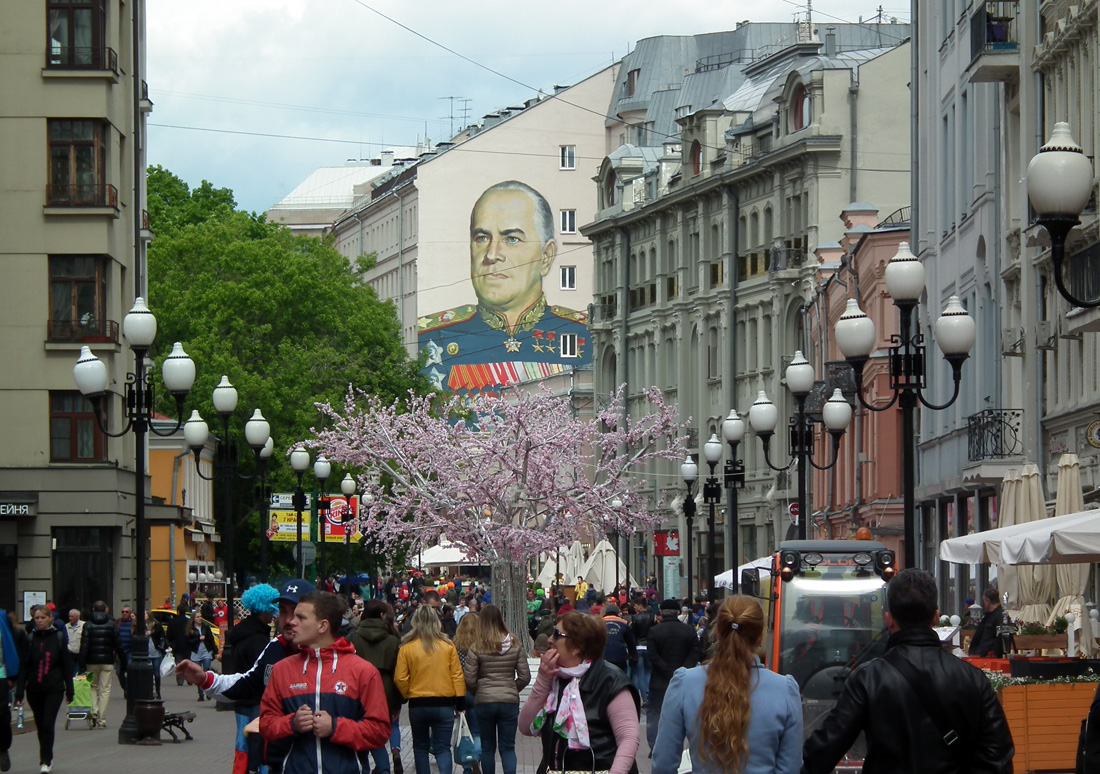 |
|||
| The figure painted on the mural is Marshall Zhukov, who played a significant role in the defeat of Nazi Germany in World War 2. | |||
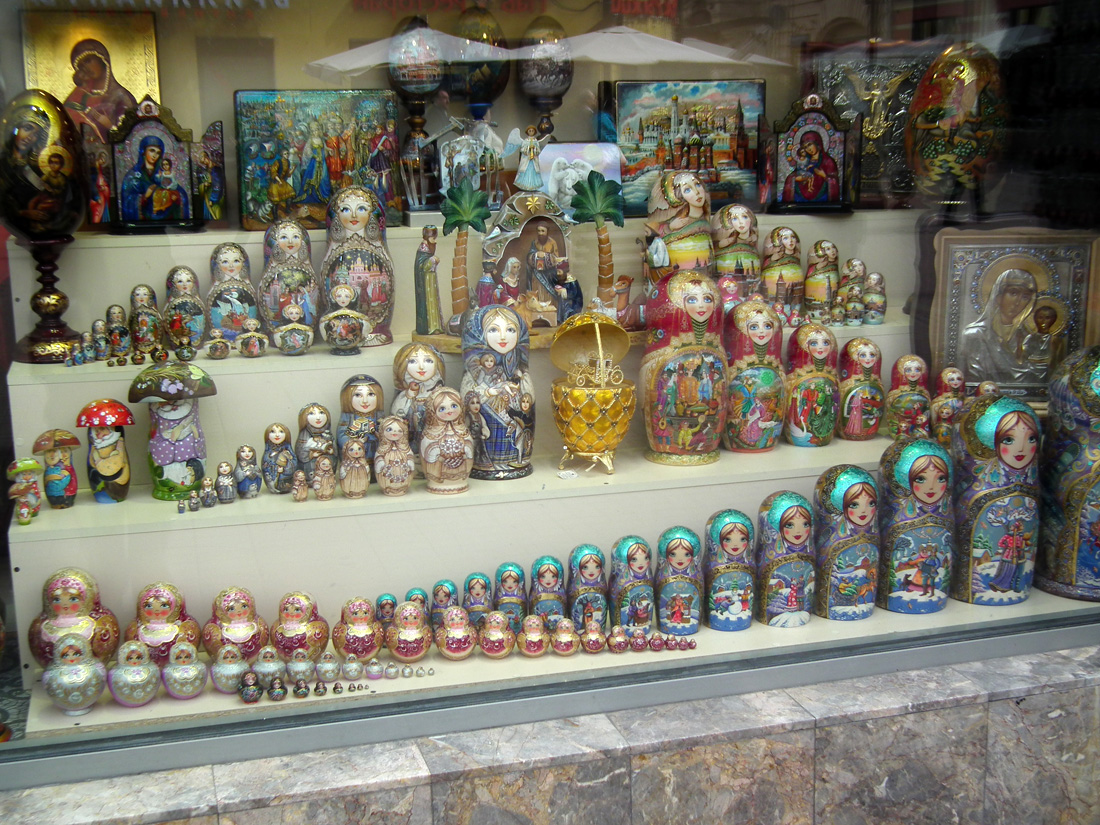 |
|||
| Matryoshka dolls in a shop window on Old Arbat. | |||
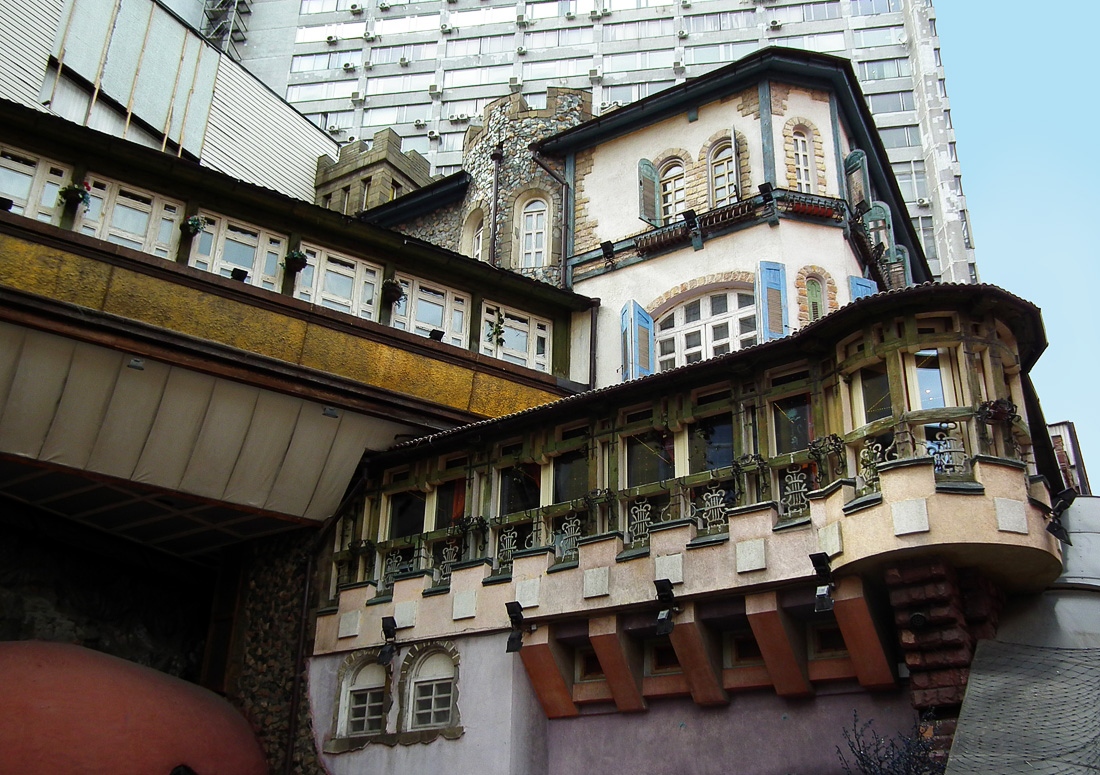 |
|||
| This was the strangest building on Old Arbat. | |||
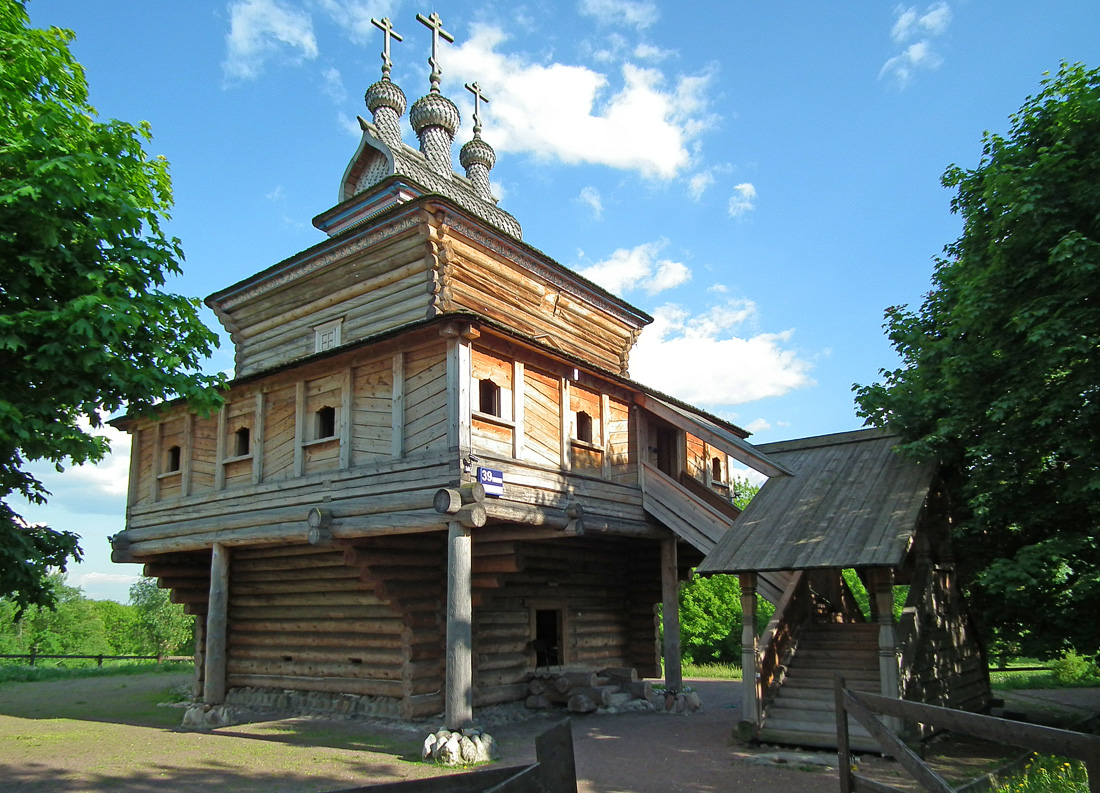 |
|||
| This is "The Church of Great Martyr St George the Victorious".
It was origianlly built in 1685 in the Arkhangelsk region, which is in the Far North of Russia. The Church was transported in pieces to Moscow and was fully restored in Kolomenskoye Park, which is in the South West of the Capital. Kolomenskoye Park runs along the Moscow River and it is now home to several traditional wooden building which have been rescued and restored. Well worth a visit. |
|||
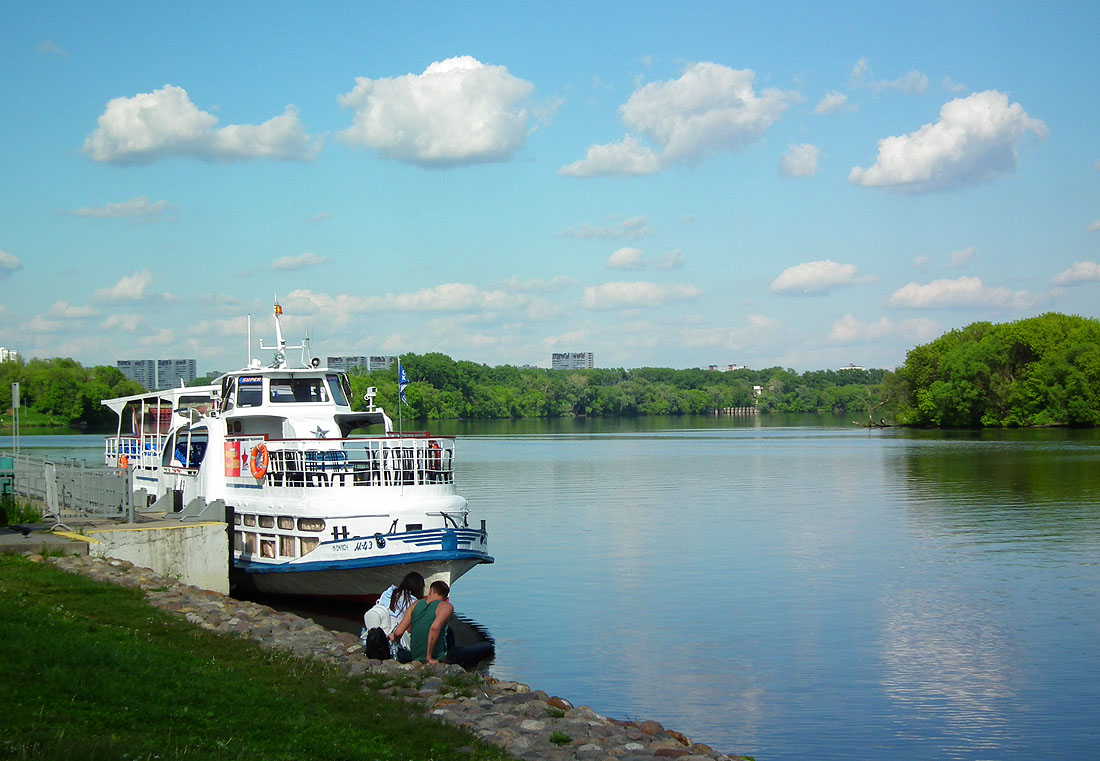 |
|||
| A view of the Moscow River from Kolomenskoye Park. This rural vista is only a few miles from the Kremlin. | |||
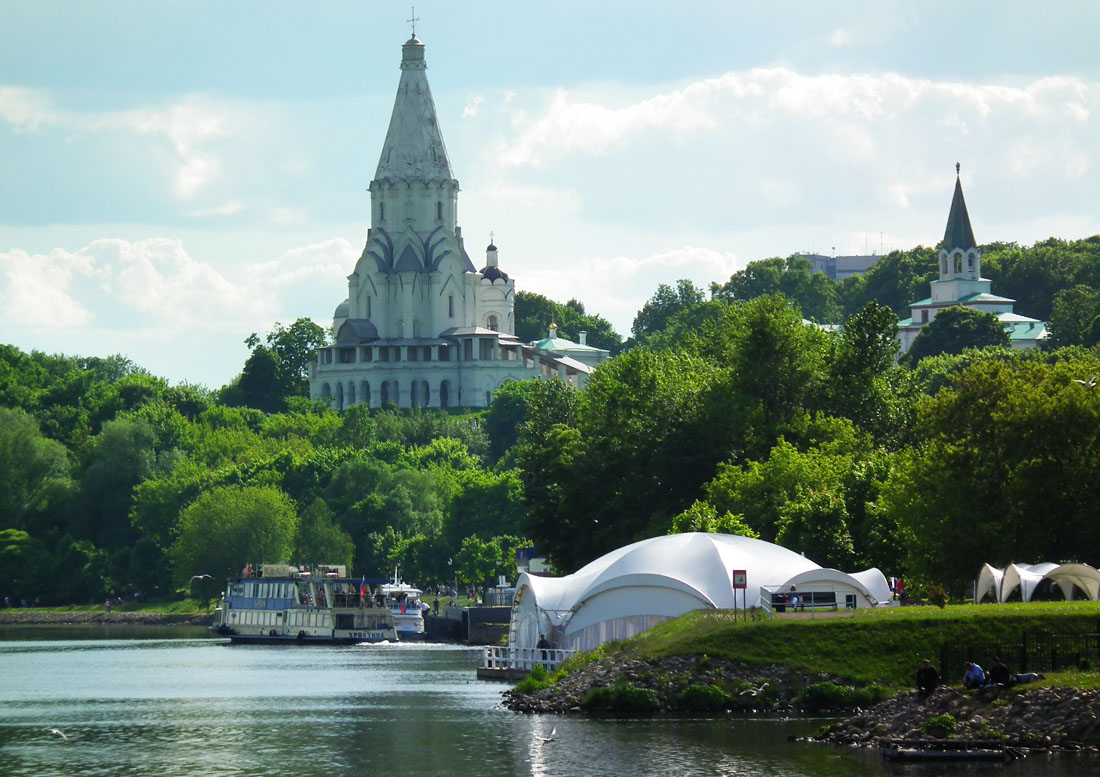 |
|||
| The tall white structure on the left is the Church of the Ascension in Kolomenskoye Park. It was built in 1532 to commemorate the birth of Ivan the Terrible. | |||
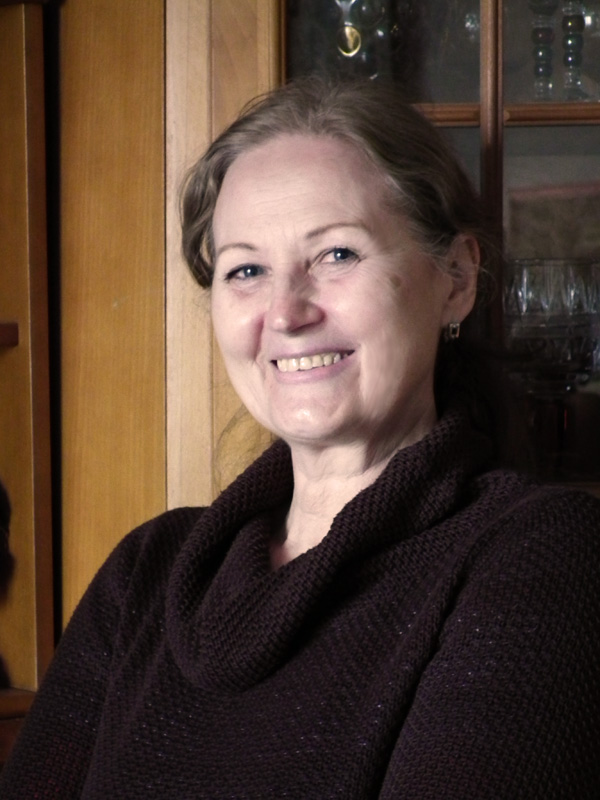 |
||||
| I can't end this page without saying a BIG thank you to Alla (pictured on the right).
We met in Sydney a while ago and when Alla heard that I was coming to Moscow she insited that I stay in her flat for free. While I was there, she moved in with her daughter and grandson and they were happy because Alla baked them lots of cakes! Alla's flat was perfect for my stay in Moscow. I could cook my meals there and there was a Metro Station literally around the corner. Before I arrived, Alla had booked online a bunch of tickets for me for walking tours and art museums. She would arrive early in the morning and take me by Metro to wherever I had to be on that day. Alla is a journalist who works in Television. I told her that when she retired from journalism she should open a tourist agency! Thanks, Alla. You helped to make my stay in Moscow very special. |
||||
|
To return to the Eastern Europe 2017 page, please CLICK HERE
|
|||